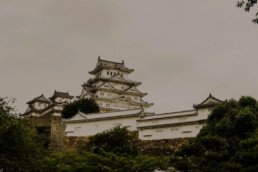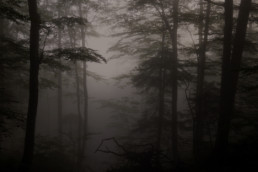Japan Travel: Ginza
Ginza: expensive, elegant and luxurious
Located in Chuō, Ginza (銀座) is Tokyo's most famous shopping area. This luxurious district was once part of the ancient Kyobashi district, which, together with Nihonbashi and Kanda, formed the core of Shitamachi, the original center of Edo-Tokyo. Built on an ancient reclaimed swamp during the 16th century, Ginza owes its name (Silver Mint) to the establishment of a silver coin mint (Silver Coin Mint) on this land in 1612.

photo credit: wikimedia.org
A devastating fire destroyed much of the area in 1872. Following this incident, the government decided that reconstruction was to use fireproof bricks to erect new buildings, and the roads should be improved and enlarged. At the same time, they should be able to connect Shimbashi station to Tsukiji. This new version of Ginza was designated as a "model of modernization" and the Irish architect Thomas Waters was given the responsibility of designing the area. In the following year, a long western-style shopping street rose with two- and three-storey Georgian brick buildings reaching from the Shinbashi bridge to the Kyōbashi bridge.


However, the high cost for both the purchase and the lease of these new buildings prevented their long-term occupations and at the same time, an issue regarding the climate arose; such buildings were not suitable for the weather conditions unique to Tokyo. To add to the issues, the design of this area contrasted with the traditional Japanese style, and as such it was not quite appreciated by visitors who were much more interested in an Edo-style town and rather than something "similar to Broadway", as described in the words of the English tour guide writer, Philip Terry.
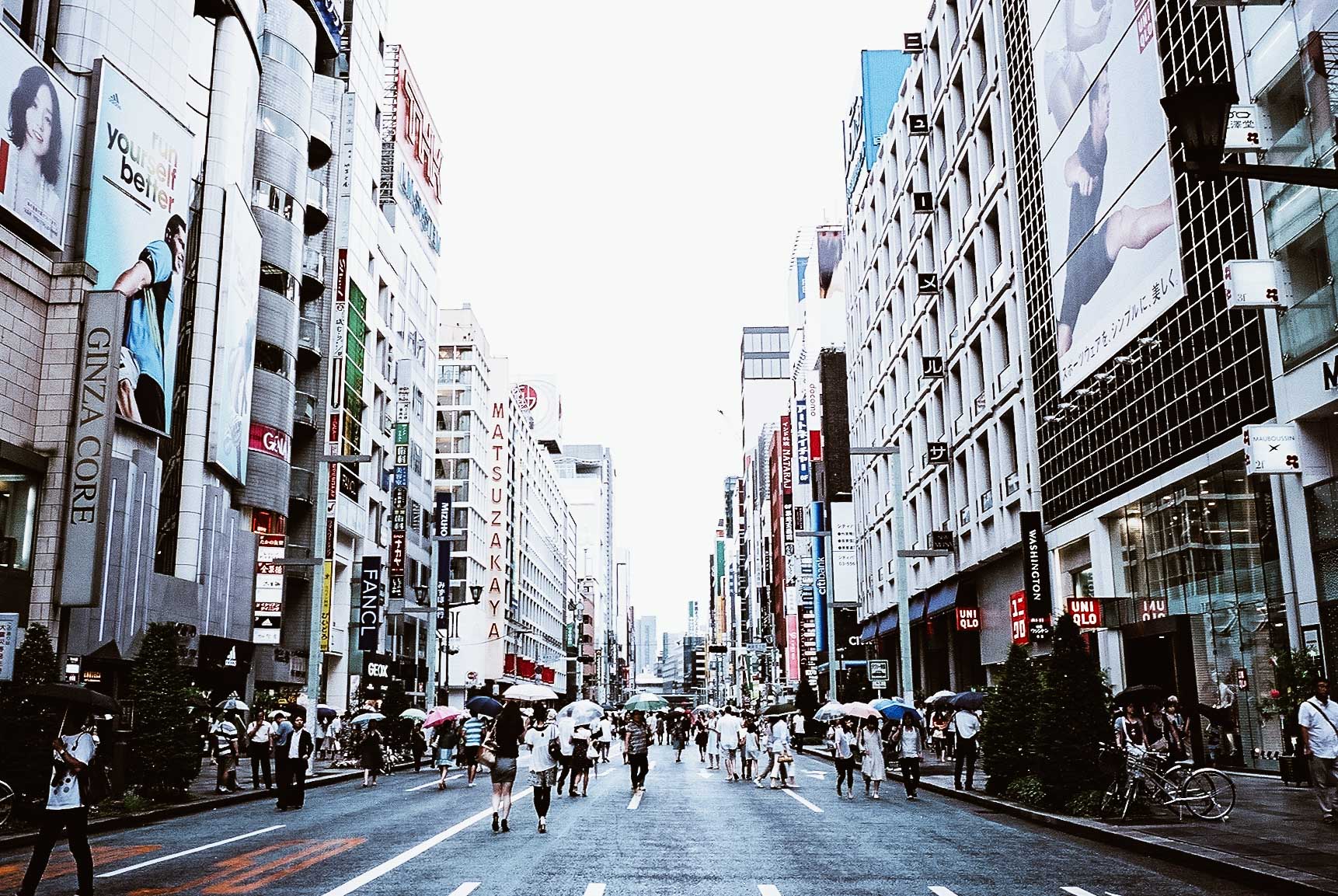
Despite stylistic problems, Ginza managed to flourish as a symbol of "civilization and enlightenment", becoming famous for its rich shop windows. In the period between the two world wars, the habit of spending time and walking through Ginza, even with no purpose, grew very popular. As time passed, most of the European-style buildings have disappeared. Among those remaining is the Wakō building, originally built by Kintarō Hattori, with its iconic Hattori Clock Tower and its luxurious gold objects inside.

photo credits: japantimes.co.jp
Not only shopping
A key stop for shoppers in Ginza is definitely Ginza Six. Opened in the spring of 2017, it is the largest shopping complex in the district. In addition to numerous cosmetic and fashion floors, there are floors dedicated to food and interior design, a large Tsutaya bookstore specializing in art publications, a pleasant rooftop garden and a Noh theater in the basement.
No less famous is the store of the chain Mitsukoshi. While this store opened in 1930, its history dates back to 1673, when it was first established. It offers products and services on twelve floors. Fans of the brand Uniqlo will find satisfaction in this 12-storey building which offers the widest range of products in the world of this brand.

Ginza, however, is not just limited shopping. For Kabuki representations, the best place is found in this part of town. It is the Kabukiza Theater. Do not miss a trip to the Yurakucho Gado-shita Dining as well. It is one of Tokyo's most interesting dining options, located under the sky train tracks, north and south of the Yurakucho station (In Japanese: Gado-shita, "under beam"). Dozens of restaurants are integrated into the brick arches below the Yamanote line which extend for over 700m. Here you can taste world-famous Japanese cuisine, or sip special wines in the luxurious French wine shops.

photo credits: harv.world
Japan Traditions: Wakakusa Yamayaki Matsuri
One of Japan's most famous matsuri is the Wakakusa Yamayaki Matsuri held in the city of Nara on the fourth Saturday of January.
photo credits: matsuritracker on flickr
Le Origini
On the top of the third hill of Mount Wakakusa we find the Uguisuzuka Kofun, a keyhole-shaped tombstone.
Legends say that in the past if the mountain was burned by the end of January in the new year, it was possible to repel deaths returning from their graves. On the contrary, if the mountain was not burned by the end of January, a big period of misfortune layed before the city of Nara. As a result, the stories tell that people passing by Mount Wakakusa began to ignite the mountain without permission.
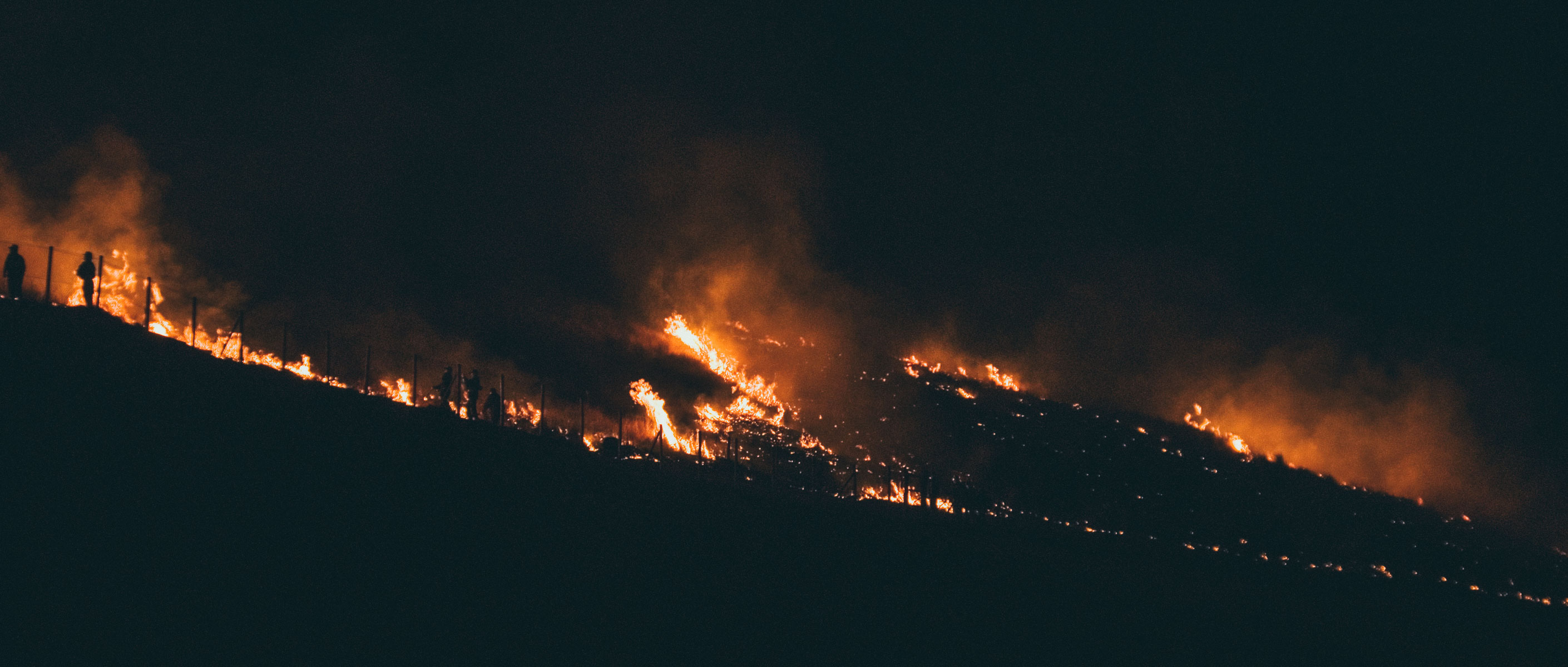
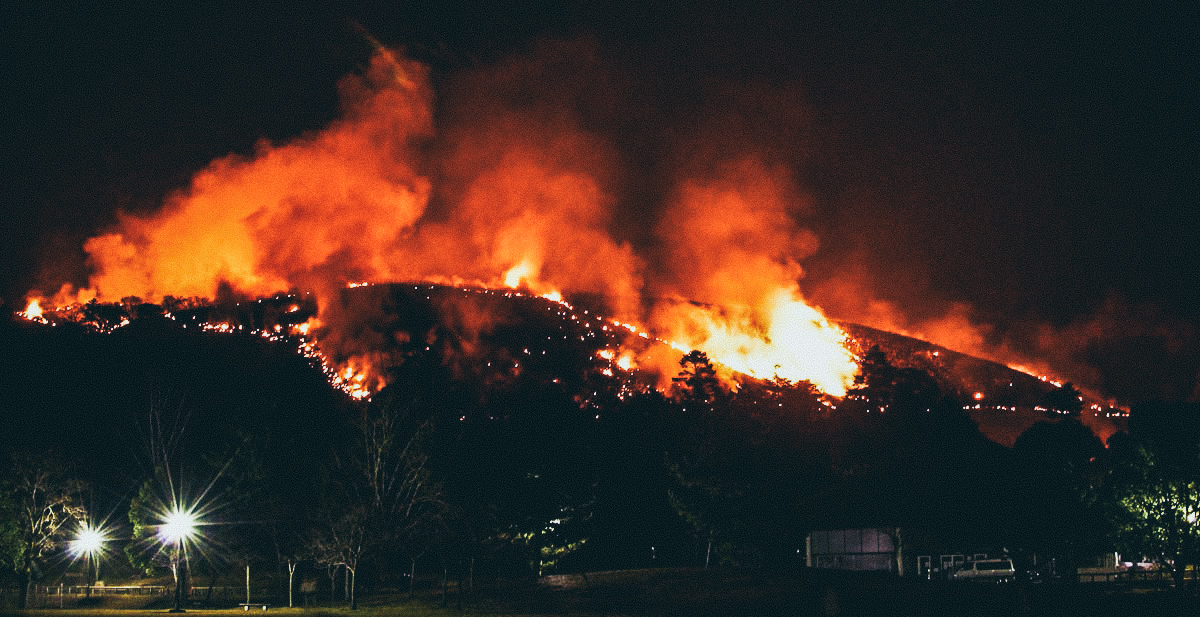
photo credits: smartus & matsuritracker on flickr
Following this, there were some incidents where the fire from Mount Wakakusa came to approach the boundaries of the Todaiji and Kohfukuji temple repeatedly. Because of this, in December 1738, the Nara magistrate's office (Bugyosho) prohibited people from burning the mountain. However, the arson fires continued at the hands of anonymous people and on some occasions approached the nearby cities and temples. To avoid similar dangers, the city of Nara established a rule to allow people to burn the mountain with the participation of representatives of the Todaiji and Kohfukuji temples along with the Nara Bugyosho at the end of the Edo period.
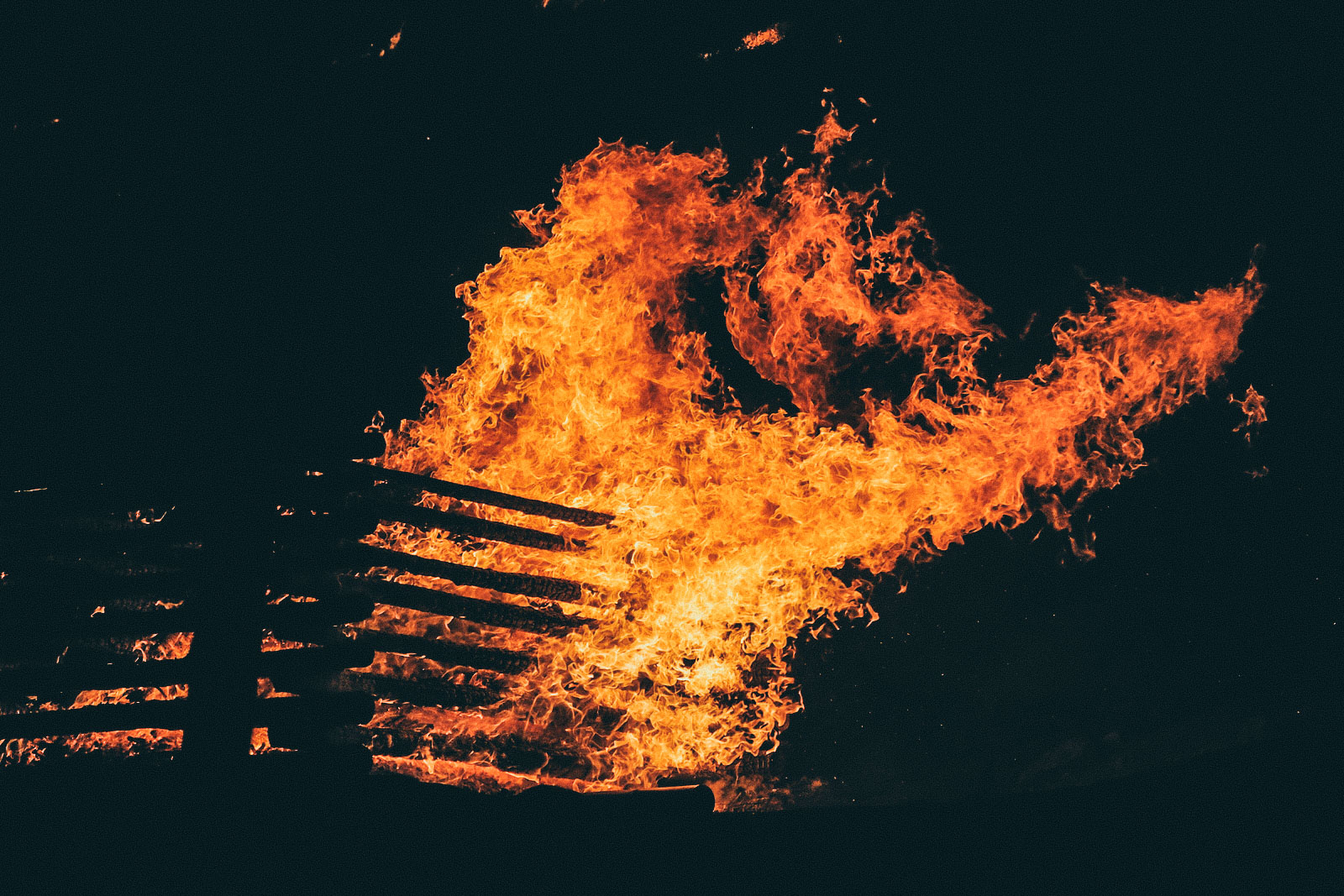
photo credits: toshimo1123 on flickr
The Yamayaki festival (burning mountain) comes from superstitions to calm the spirits of the dead at the Uguisuzuka Kofun located at the top of the mountain, so the Yamayaki could also be considered as a moment of service in memory of the dead.
Modern history and present day
Since 1900, there have been a series of changes related to Wakakusa Yamayaki Matsuri. Firstly, the time was shifted from day to night and even its date moved to 11 February (Day of the Empire), although during the period of World War II, the celebrations were held during the afternoon. Later, in 1910, the organization passed into the hands of the prefecture of Nara.


photo credits: karihaugsdal on flickr
After the end of the war, the Yamayaki once again became an evening event together with a fireworks display of over one hundred fireworks.
During the fifties, the date of the Yamayaki was moved to January 15, the "Coming of Age day", while in 1999, due to the implementation of the so-called "Happy Monday System Act" (law that moved some public holidays on Mondays) , the festival was celebrated on the Sunday before the "Coming of Age day".
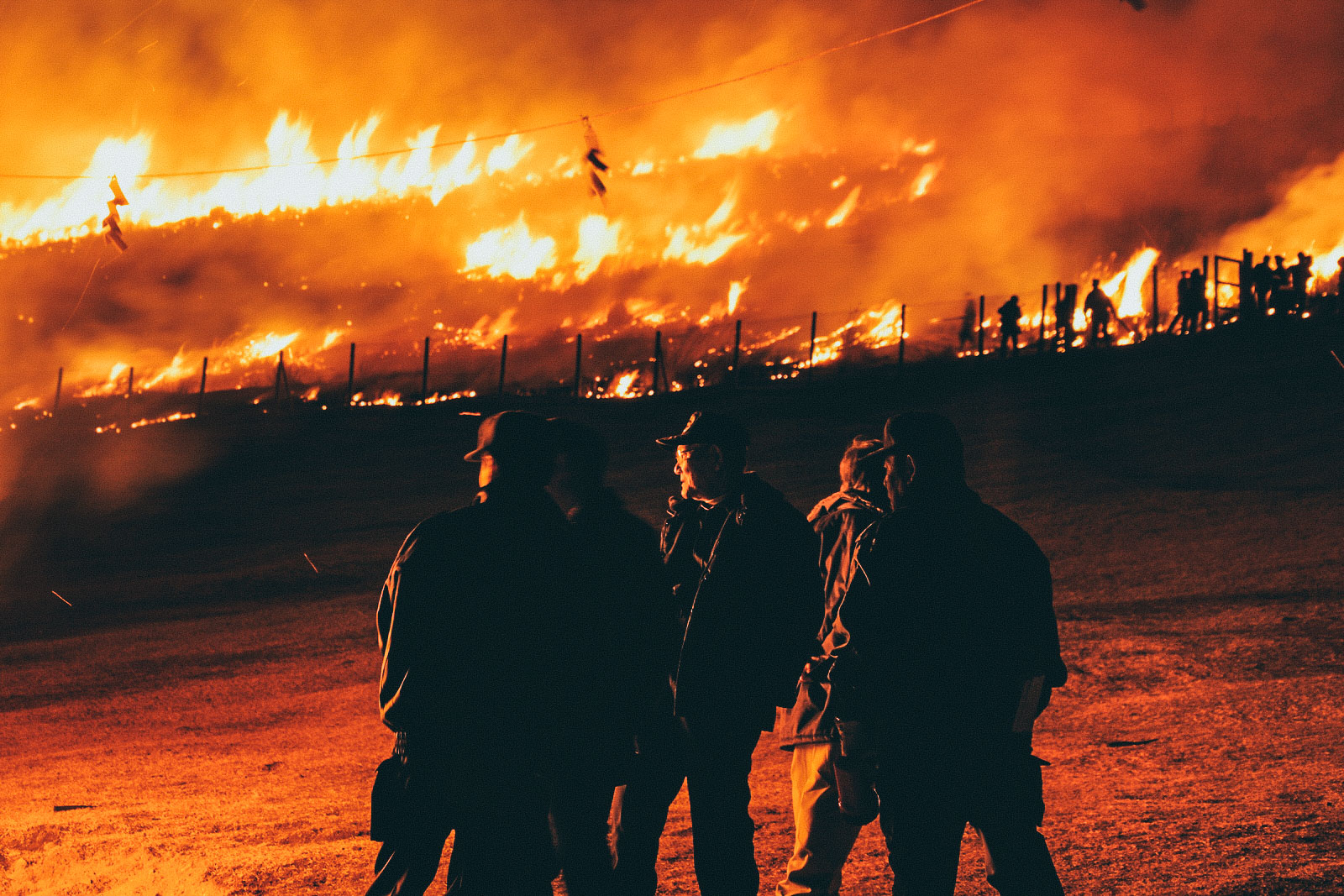

photo credits: toshimo1123 & nwhitely on flickr
Since 2009 we find the combination that still exists today, where the event is held on the fourth Saturday in January with a fireworks display of hundreds of fireworks.
On this matter, this is the only event in Nara that uses the Shakudama fireworks that have a diameter of over 30cm. An absolutely magical fireworks display that we guarantee will always remain engraved in your memories.
Mount Wakakusa
Mount Wakakusa is 342 meters high and 33 hectares wide and is covered with grass with delicate slopes. Here you can see deers, seasonal flowers and plants, like the traditional Japanese cherry trees in spring and the fantastic autumn colors typical of Japan. Also from its top, it is possible to see the whole panorama of the city of Nara with all its historical part.

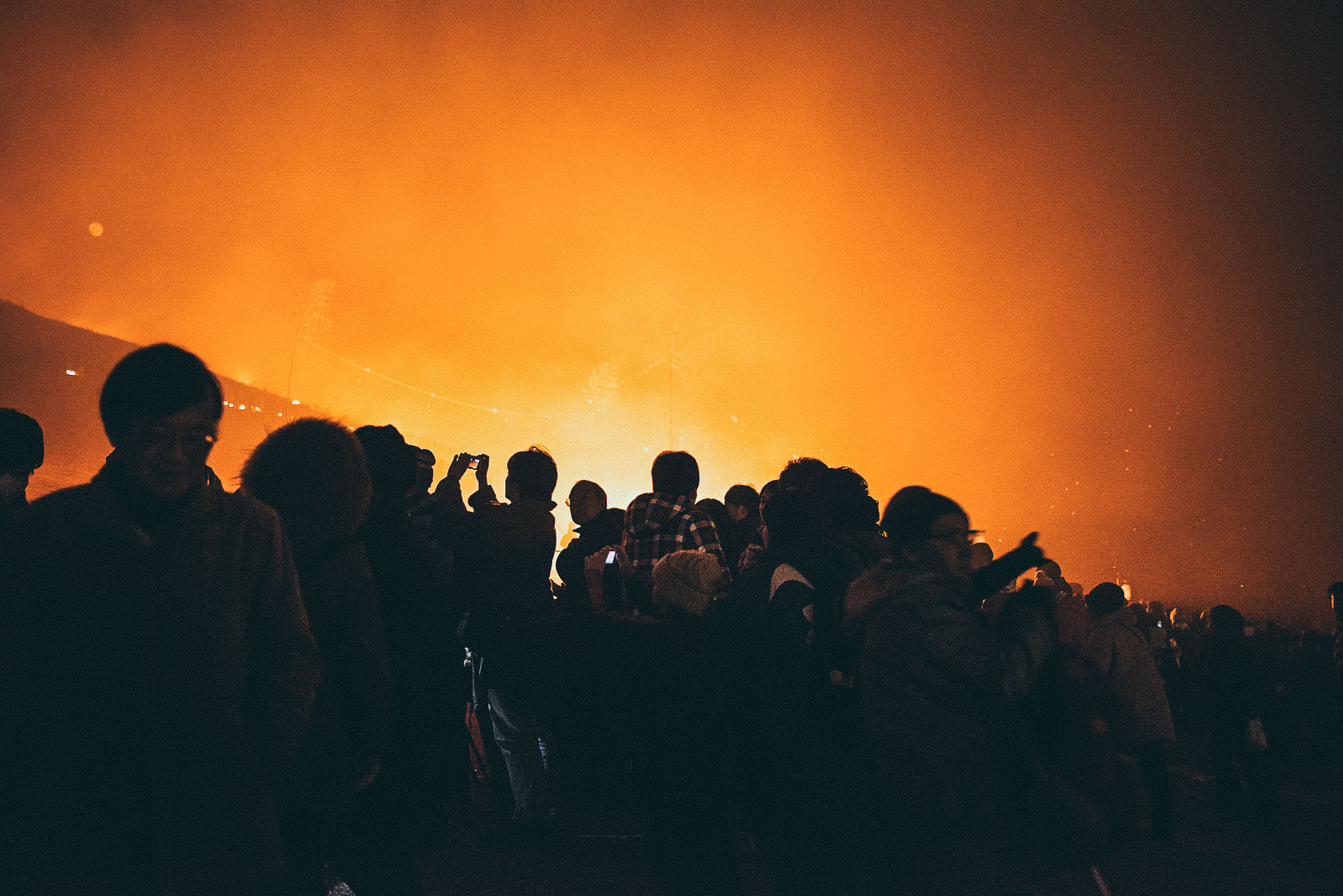
photo credits: 158175735@N03 & mashipooh on flickr
Mount Wakakusa is surrounded by many UNESCO world heritage sites such as the temples Todaiji and Kohfukuji and the spring forest of Mount Kasuga, so be very careful to avoid accidents such as spreading the fire.
The parade
Led by the sound of shell horns played by the mountain priests of the Kinpusenji Temple, more than 40 people face the solemn parade through the park, wearing the traditional costumes of the representatives of the temples of Kasugataisha, Todaiji and Kohfukuji and of the officers of the judiciary office of Nara in the Edo period.
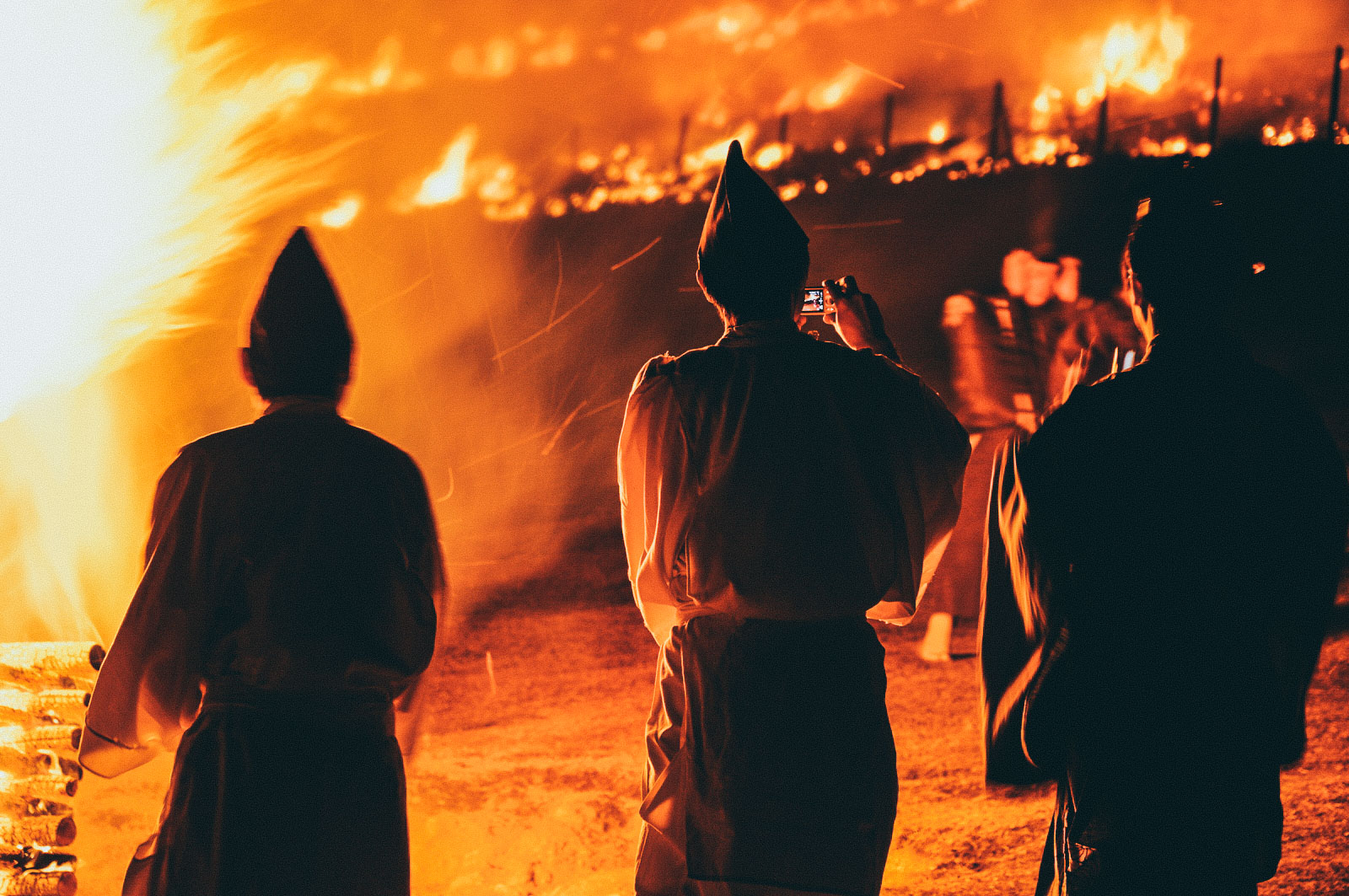
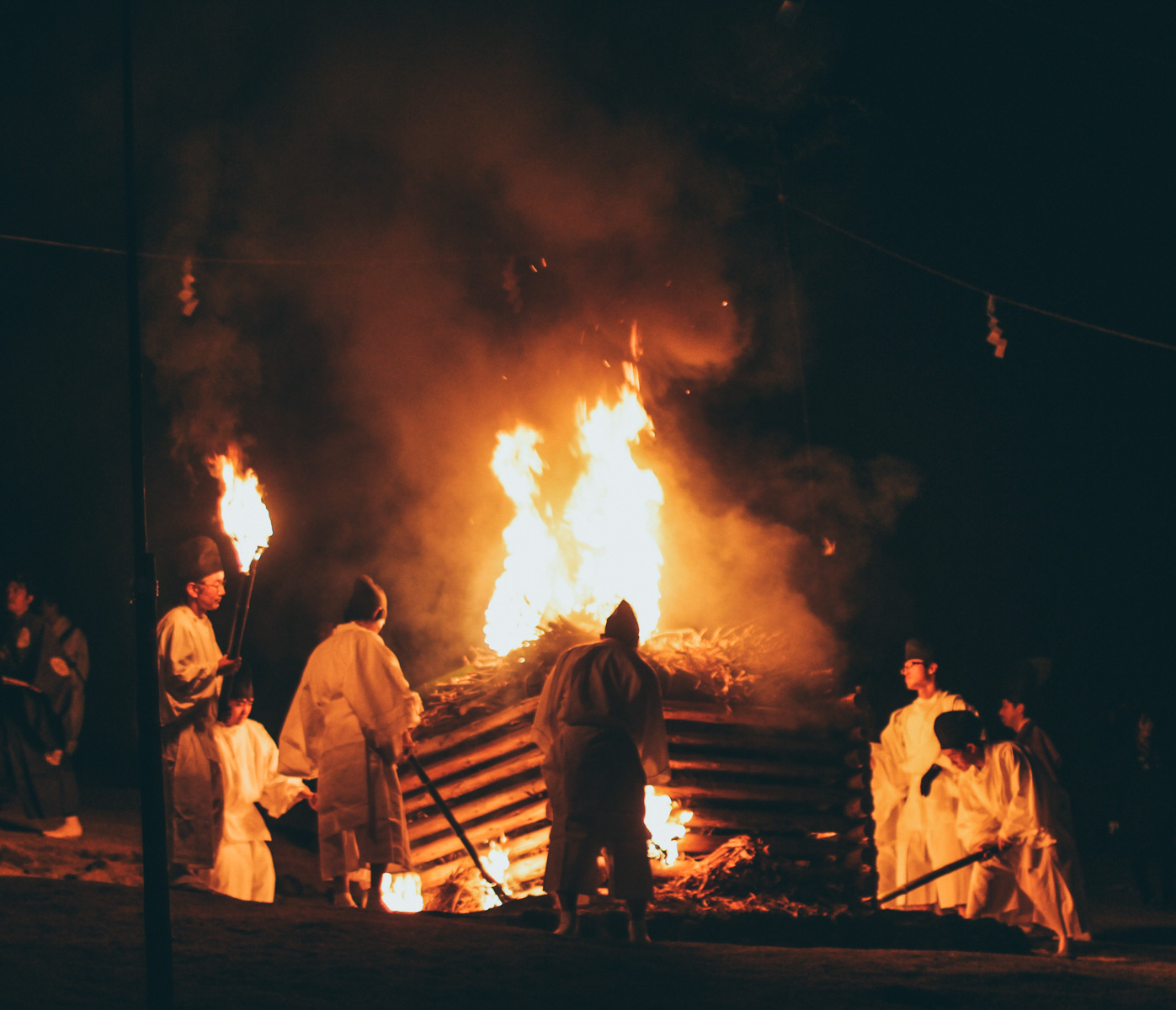
photo credits: toshimo1123 & katiefujiapple on flickr
The event begins with the Gojinkahotaisai, the sacred fire acceptance ceremony held at the Tobohino park, on the site of the Great Round Bonfire. In this ceremony, the sacred fire is transferred from the Great Round Bonfire to the torches. Following this, the parade will take the sacred fire to the Nogami temple. Once arrived at the Mizuya temple, the sacred fire brought by time Kasugataisha will be transferred to a series of torches. Once at the Nogami Temple, at the base of Mount Wakakusa, the sacred fire forms another great bonfire.

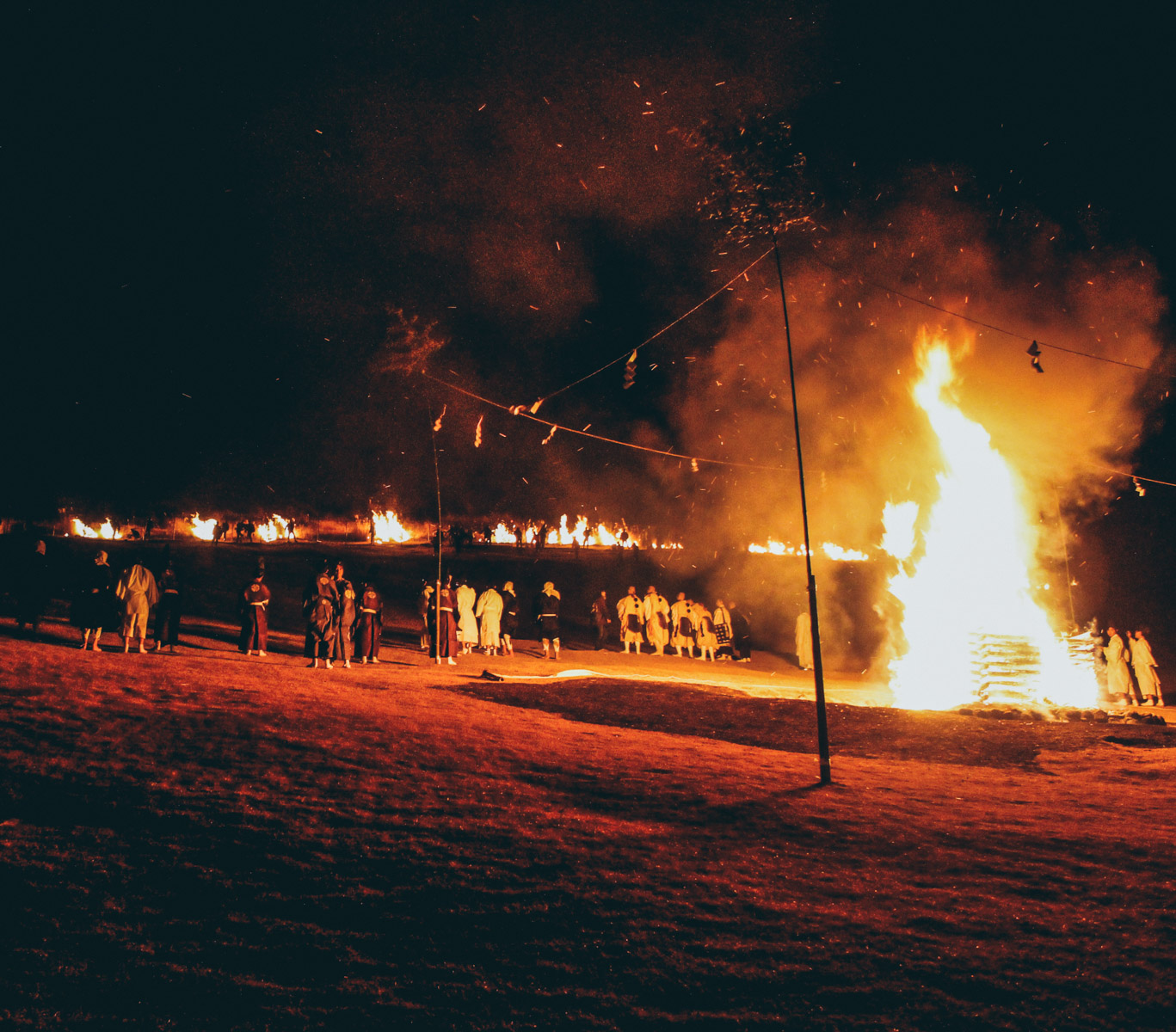
photo credits: katiefujiapple on flickr
During the parade, the fire is accompanied by constant prayers in the first place for the safety of the Yamayaki. The fire is then transferred back to the torches, accompanied by the songs of the priests of the temples Todaji, Kohfukuji and Kinpusenji. At this point, the parade moves towards the big bonfire in the center at the base of the mountain where it is lit, thus giving birth to the spectacle of light and heat.
photo credits: nara-park.com
Access
Mount Wakakusa is about a 10 - 15 minute walk from the Todaiji temple and Kasuga Taisha. The mountain can also be reached on foot from Kintetsu Nara station in about 35 minutes or from JR Nara station in about 50 minutes. Alternatively, you can use buses departing from both the station and Kasuga Taisha for a small fee.
If you are in Japan during this period, the next Yamamaki will take place in a few days, January 26, 2019. Do not miss it and we’ll wait for your stories!

photo credits: ks_photograph
Japan Travel: Meiji Shrine
The Meiji Era
The Meiji Period (明治 時代 Meiji jidai, "period of the illuminated kingdom") is one of Japan's most famous historical moments. It expands from October 23, 1868 until July 30, 1912 and includes the 44-year reign of Emperor Matsuhito.

photo credit: Wikipedia
Following the fall of the Tokugawa Yoshinobu shōgunate, the era of Emperor Meiji, the first with political power, began. It is precisely during these years that the political, social and economic structure of Japan began to change based on the Western model.
Following the death of Tokugawa Ieyasu in 1866, Tokugawa Yoshinobu was named as his successor, remaining in power a few months, until November 1867, when the shōgun submitted his resignation and ceded his powers to the court. In January 1868, Tokugawa's troops were replaced in Kyoto by a coup. And it is precisely in this period that the Meiji Restoration begins, restoring power to the emperor after centuries of shogun’s rule.

photo credit: Wikipedia
The first action exercised by the new Meiji government was to give some more privileges to the samurai class, which remained dissatisfied with the previous regime. Following the numerous contrasts in 1869 the daimyō were appointed governors of their feuds. However, the latter were suppressed in 1871, allowing the "formal" centralization of power and the reinforcement of the imperial institution. Not everyone agreed to the renunciation of their feuds, but to maintain order and stability, the government persuaded the daimyō with promises of strong rewards.
Along with this compromise, the government also compromised with the samurai class, approving a law that allowed them to carry out any occupation in the business field and public administration (the most popular were the institutional police body and the imperial army) . As a result of this, the maintenance of the samurai class was taken over by the central government, also by giving the remuneration.
In this new state, the image of the emperor became more and more significant and in June 1869, with the "oath of the Charter" in favor of the emperor Meiji, the first constitution was born. Here the full powers of the central government were enunciated, even if the political decisions of the country were still entrusted to an oligarchic government.
Until 1881, the regime governed in an authoritarian way with no opposition from the ruling class, but it is in this year that a great crisis broke out. Here, with a request to the emperor, he invoked the desire to transform the government into a parliamentary form.

photo credit: Wikipedia
Despite the difficulties, the Meiji period remains one of the most important eras and one with more changes in Japanese history. It is here that the foundations were laid for today's government of the Land of the Rising Sun.
The Meiji temple
Located in the heart of Tokyo and surrounded by a natural and urban forest, the Meiji-Jingu is a pearl of Shintōism and one of the city's most symbolic sanctuaries.


Located in the Yoyogi park, in Shibuya, the structure was completed in 1920, in honor of Emperor Meiji (1852 - 1912) and his wife Shôen (1849 - 1914). The shrine was also the victim of the bombings during the Second World War, but rebuilt completely soon after. This is a great demonstration of Japanese gratitude to this emperor, and the most striking example is the huge park that surrounds this place of worship, with more than one hundred thousand trees sent by the inhabitants of the archipelago in honor of the memory of this emperor.
To access the sanctuary, still in activity, you have to cross the large surrounding forest and pass under the magnificent Torii in cypress. Before you can enter the courtyards and sacred buildings, you must respect some rules of etiquette, such as the purification of the body with water and the greeting to the Torii.

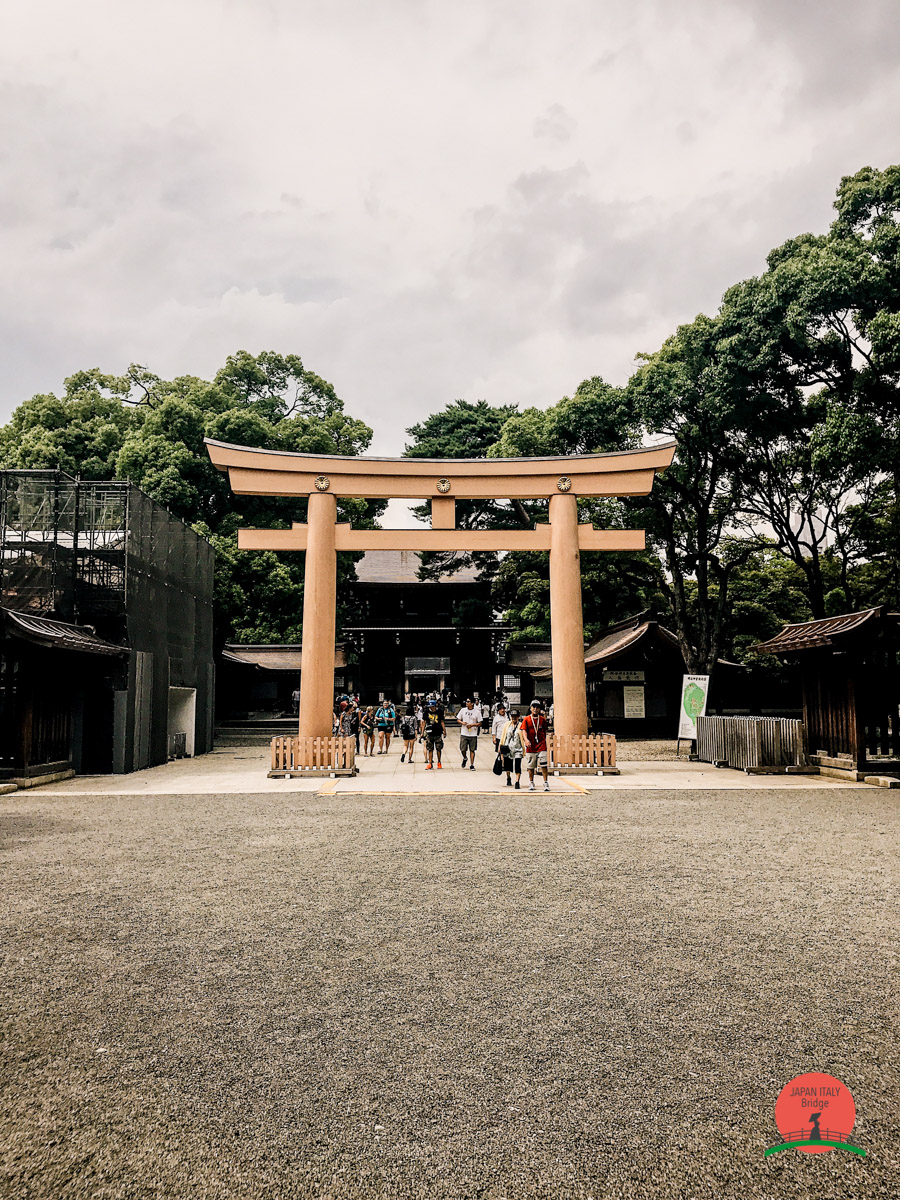
It's amazing how after passing the big Torii gate, Tokyo's noisy comings and goings are replaced by the quiet sounds of the forest and the thick foliage of trees. Here temple visitors can take part in typical shinto activities, such as offerings in the main area, buying goodies and amulets, or writing your own wishes on the famous ema tablets. It is not rare, in fact, to find people of all ages who buy these wooden tablets and express their desire by writing on these supports. Once you have expressed your wish, you can hang the ema on a central support in the temple and subsequently they will be recovered by the priests who will then send messages to the Kami (gods).
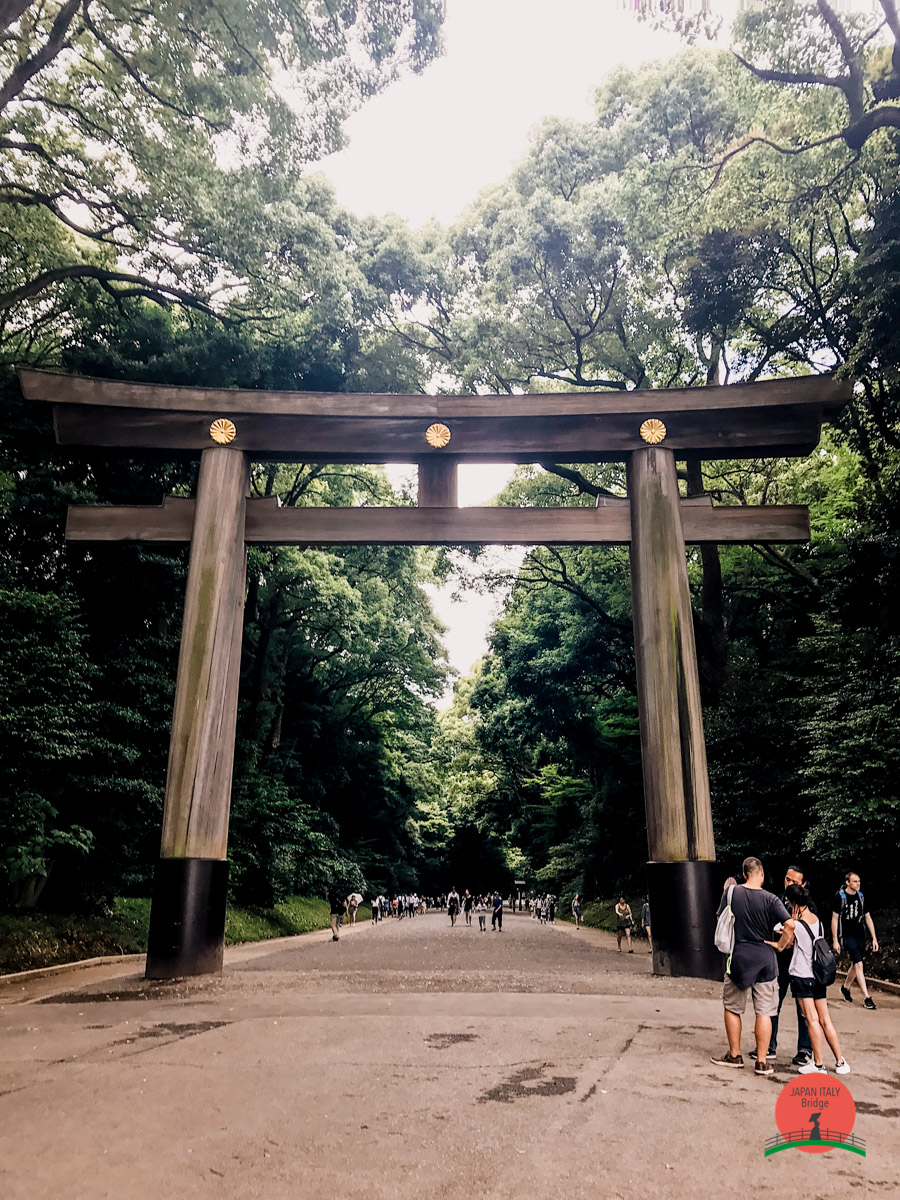
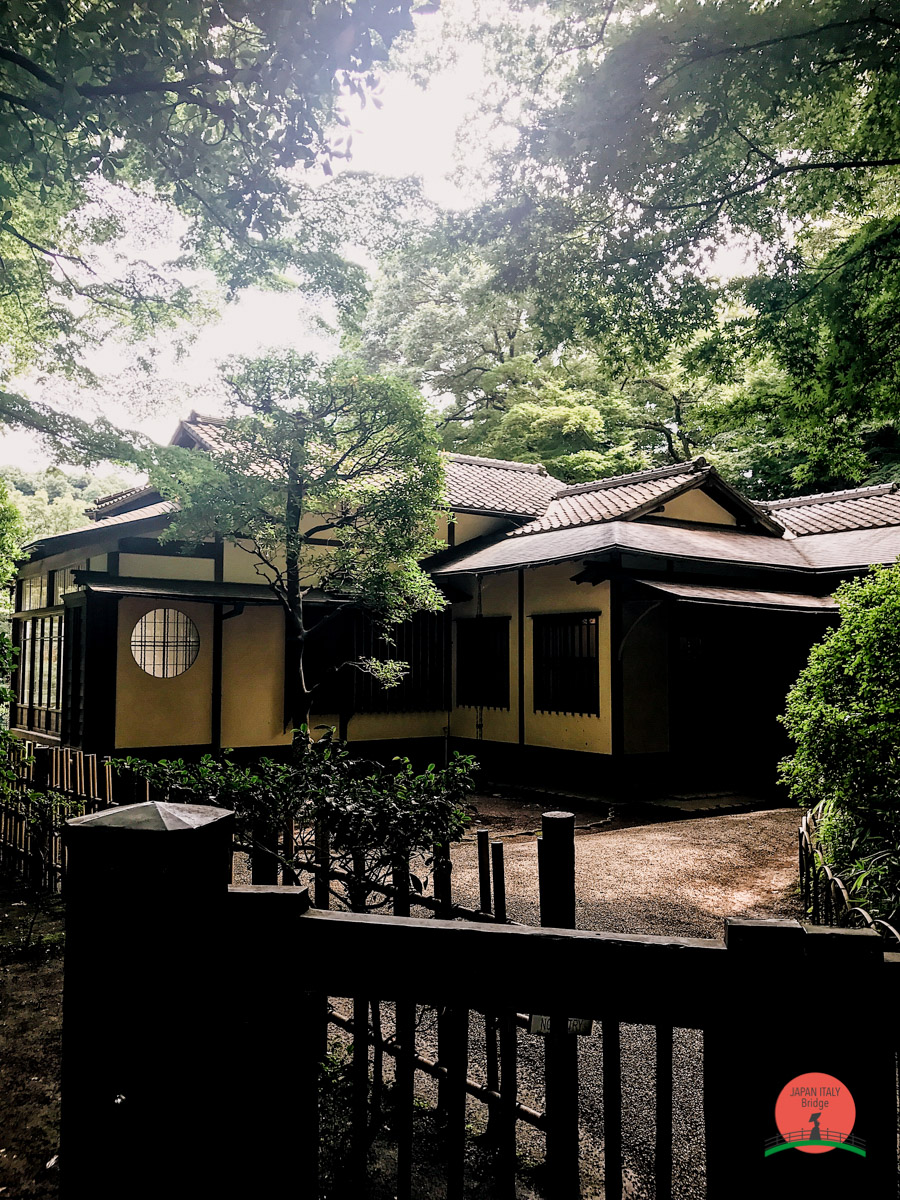
The Meiji Jingu is one of the most popular temples in Japan and at this time of year, just after the Omisoka, it regularly welcomes more than three million visitors for the Hatsumode, the first prayers of the year.
In the northernmost part of the temple-related lands, visitors can find the treasure house of the Meiji Jingu, built a year after the temple was opened. In this place are contained many personal objects related to the Emperor and the Empress, including the carriage that accompanied the emperor to the formal declaration of the Meiji constitution in 1889.


A large area of the southern part of the temple lands is occupied by the Interior Gardens, which require a small entry fee. These gardens are particularly popular in mid-June to admire the blooming of the Iris flowers in all their glory, together with the famous Japanese gruidae birds. And if you have enough patience, you might have the opportunity to see a small flock of these fantastic birds cross the lake, a unique and magical spectacle.
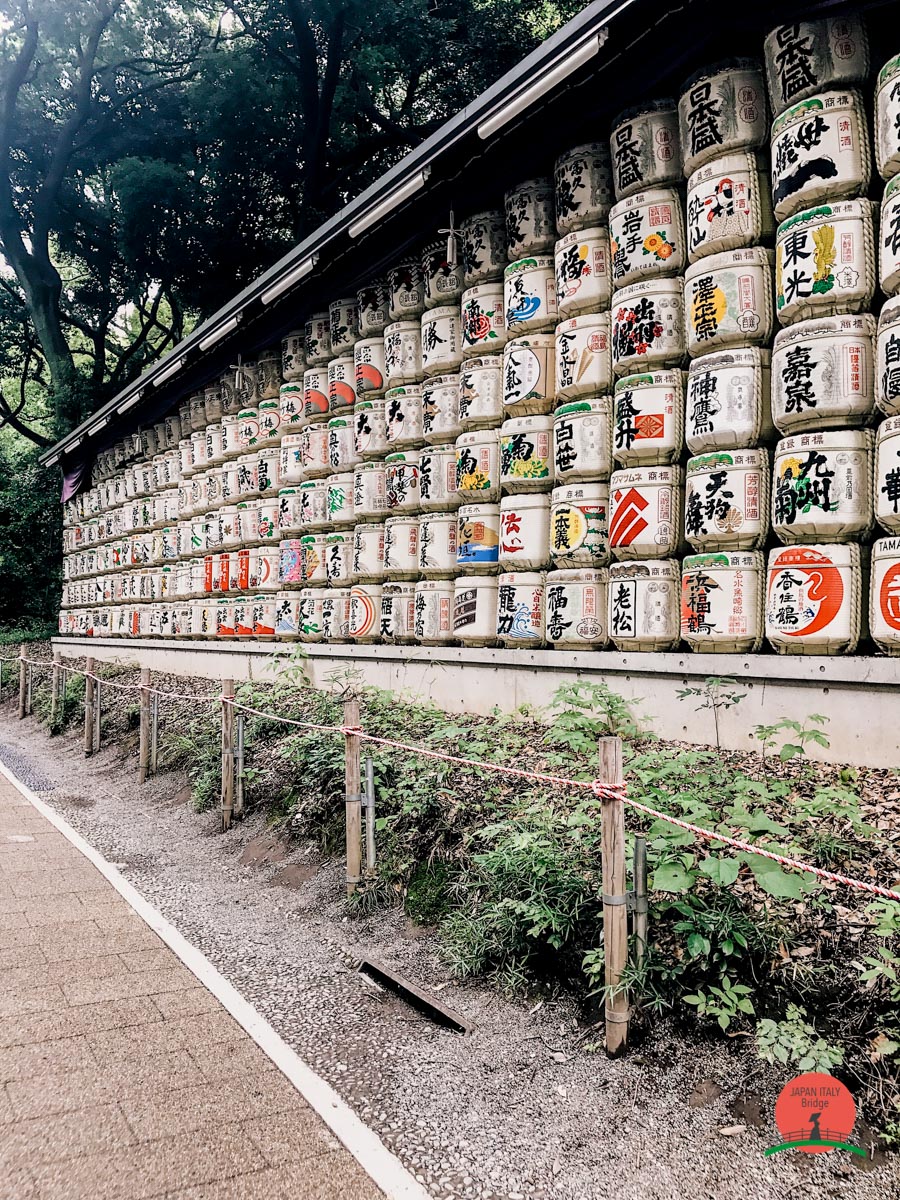
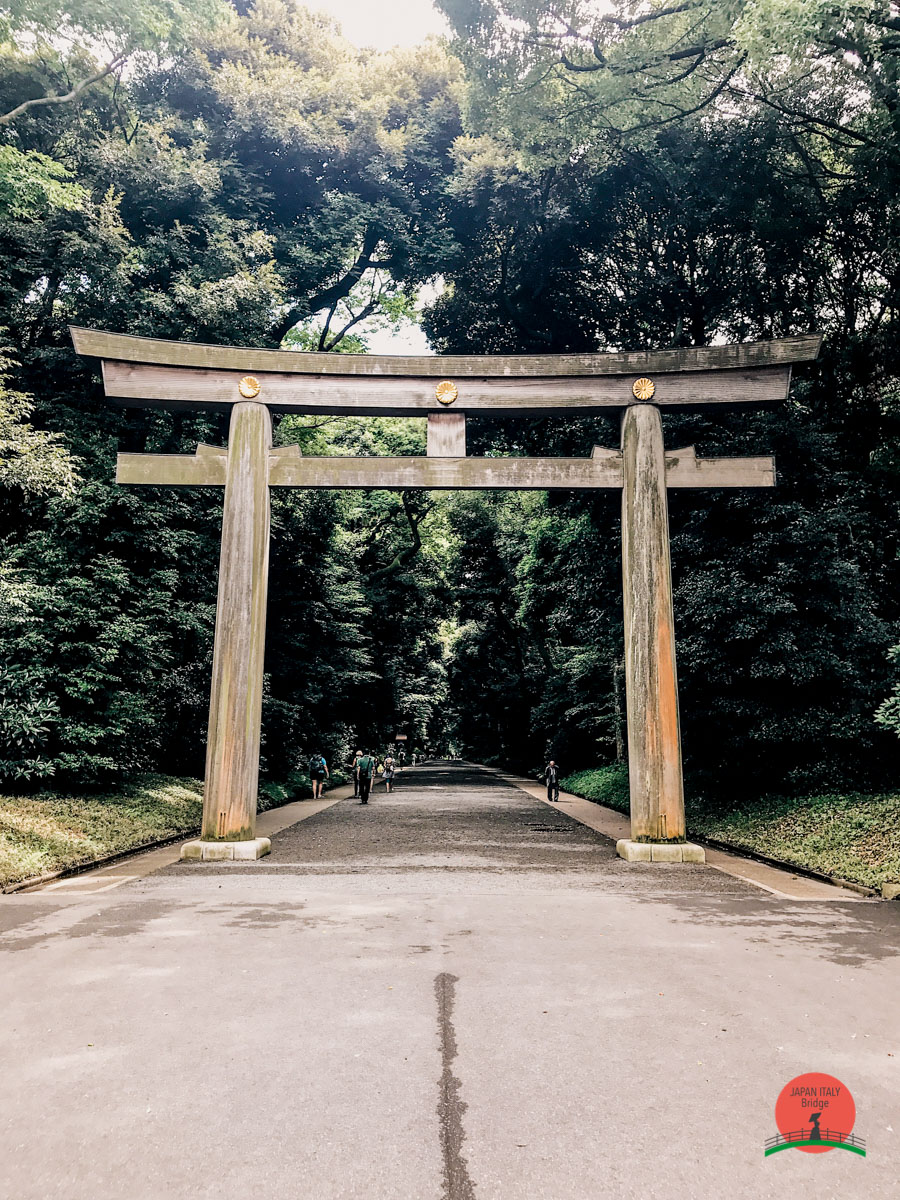
Also, walking along the inner streets of the temple and the park, you can come across what I call "wall of sake", a wall of gigantic sake barrels, a gift for the emperor by all the sakagura of Japan . Opposite this wall, on the other hand, it is possible to find a wall of wine barrels, a gift to the emperor from all the foreign nations.
Also, in preparation for the 100th anniversary in 2020, renovations are taking place for some of the temple buildings, scheduled until October 2019, so if you plan to visit Tokyo in 2020 you can not miss this goal, between an Olympic race and the other!
Japan Travel: The imperial Palace & Gardens

photo credit: Google Images
I’ve been to Tokyo a few times now and one of my favourite spot in the whole city are the Imperial East Gardens in the Chiyoda area. Whenever I’m in the city, I always find a moment (sometimes even more than one) to visit this amazing place, a green heart in Tokyo, full of history and tradition but surrounded by the modernity of this frantic city.
The Tokyo Imperial Palace (皇居 Kōkyo, literally "Imperial Residence") is the primary residence of the Emperor of Japan. With its large parks it is located in the heart of the Chiyoda ward and contains buildings including the main palace (宮殿 Kyūden), the private residences of the Imperial Family, an archive, museums and administrative offices.
The current palace is built on the site of the old Edo Castle built by the shogun Tokugawa Ieyasu and the total area including the gardens is 1.15 square kilometres.
The history
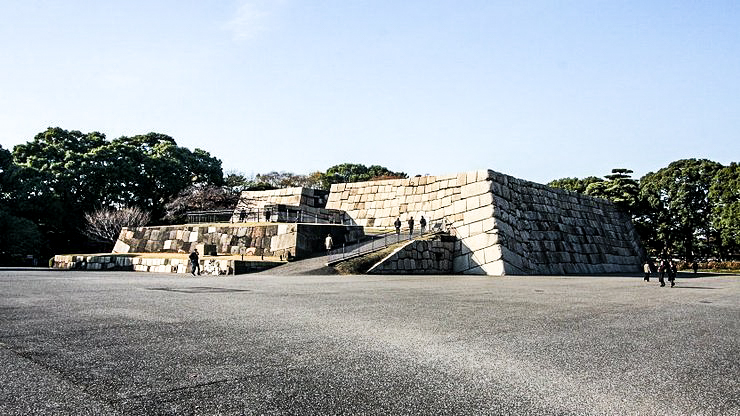

photo credit: japan-guide.com
Edo castle
Built by Tokugawa Ieyasu and assigned it to be the residence of the Tokugawa family, after the end of the shogunate and the Meiji Restoration, the Emperor left the Kyoto Imperial palace and moved to Edo Castle. This became his new residence and it was renamed to Tōkei Castle (東京城 Tōkei-jō), at this time, Tōkyō had also been called Tōkei.
On 5th May 1873, the Nishinomaru Palace (formerly the shōgun's residence) was destroyed by a fire, and the new imperial Palace Castle (宮城 Kyūjō) was constructed on the site in 1888.
The non-profit organisation "Rebuilding Edo-jo Association" (NPO法人 江戸城再建) founded in 2004 has the aim of a historically correct reconstruction of at least the main donjon. This group plans to collect donations and signatures on a petition in support of rebuilding the tower of the old castle so that the capital city can have a symbolic building.


photo credit: Wikipedia, thetraveltester.com
The Old palace
In the Meiji era, most structures from the Edo Castle disappeared. Some were cleared to make way for other buildings while others were destroyed by earthquakes and fire.
In this case, the wooden double bridges (二重橋 Nijūbashi) over the moat were replaced with stone and iron bridges while the buildings of the Imperial Palace constructed in the Meiji era were made of wood.
When you first face the Imperial Palace you are suddenly transported into the classical and traditional Japanese architecture, but if you have the chance to walk those halls you’ll discover that on the inside, the palace is a mixture of then-fashionable Japanese and European elements. Western chairs, tables and heavy curtains furnish the spaces, the floors of the public rooms have parquets or carpets while the residential spaces us traditional tatami mats.
Guests were received in the main audience hall, which was the central part of the palace. Its floor space was more than 223 tsubo (approximately 737.25 m2 - 7,935.7 sq ft) and the interior the ceiling was in traditional Japanese-Style, while the floor was made out of parquet. For the roof, a style similar to the Kyoto Imperial Palace was maintained, however it was covered with fireproof coppered plates rather than the traditional Japanese cypress shingles.
More concrete buildings were added in the late Taishō and early Shōwa period, such as the headquarters of the Imperial Household Ministry and the Privy Council.
During the Second World War, on the night of 25th May 1945, most structures of the Imperial Palace were destroyed in the Allied firebombing raid on Tokyo. Due to this, a new main palace hall (宮殿 Kyūden) and residences were constructed on the western portion of the site in the 1960s and this area was renamed Imperial Residence (皇居 Kōkyo) while the eastern part was renamed East Garden (東御苑 Higashi-Gyoen) and became a public park in 1968.
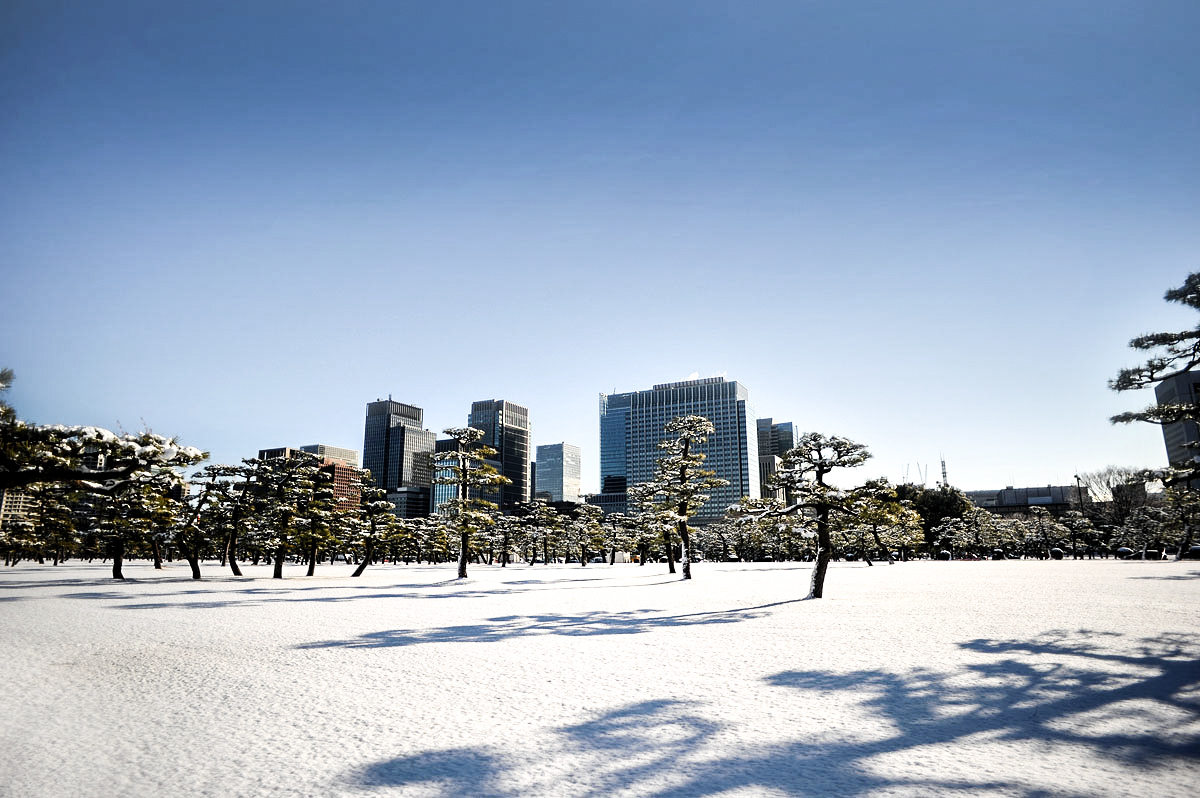
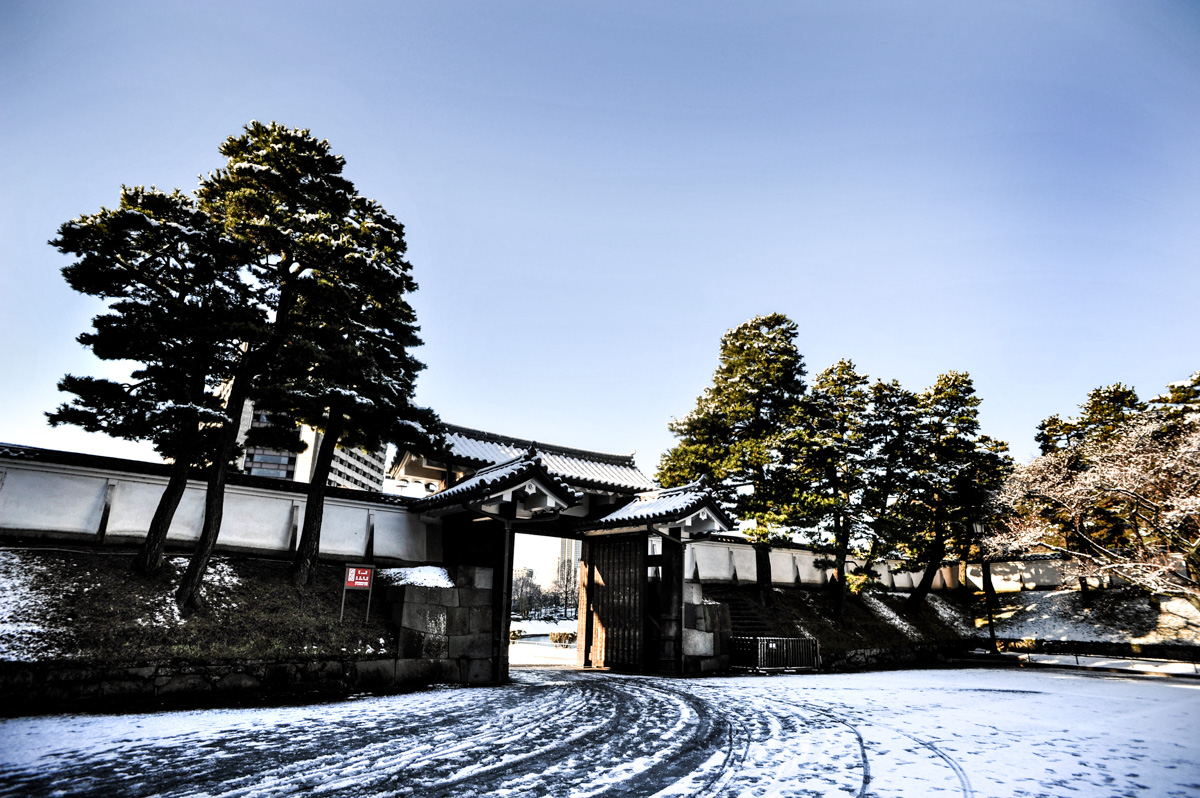
photo credit: tokyobling.wordpress.com
The Imperial Palace today
After surviving defining moment in history, the modern palace Kyūden (宮殿) was designed for various imperial court functions and reception is located in the old Nishinomaru section of the palace grounds.
As of today, the residence of the current Emperor and empress is located in the Fukiage Gardens and it is now on a much more modest scale, compared to what originally was.
Except for Imperial Household Agency and the East Gardens, the palace is generally closed to the public, except for reserved guided tours from Tuesdays to Saturdays. Each New Year (January 2) and Emperor's Birthday, the public is permitted to enter through the Nakamon (inner gate) where they gather in the Kyuden Totei Plaza in front of the Chowaden Hall. On this occasion, the Imperial Family appears on the balcony before the crowd and the Emperor normally gives a short speech greeting and thanking the visitors and wishing them good health and blessings.
The Gardens
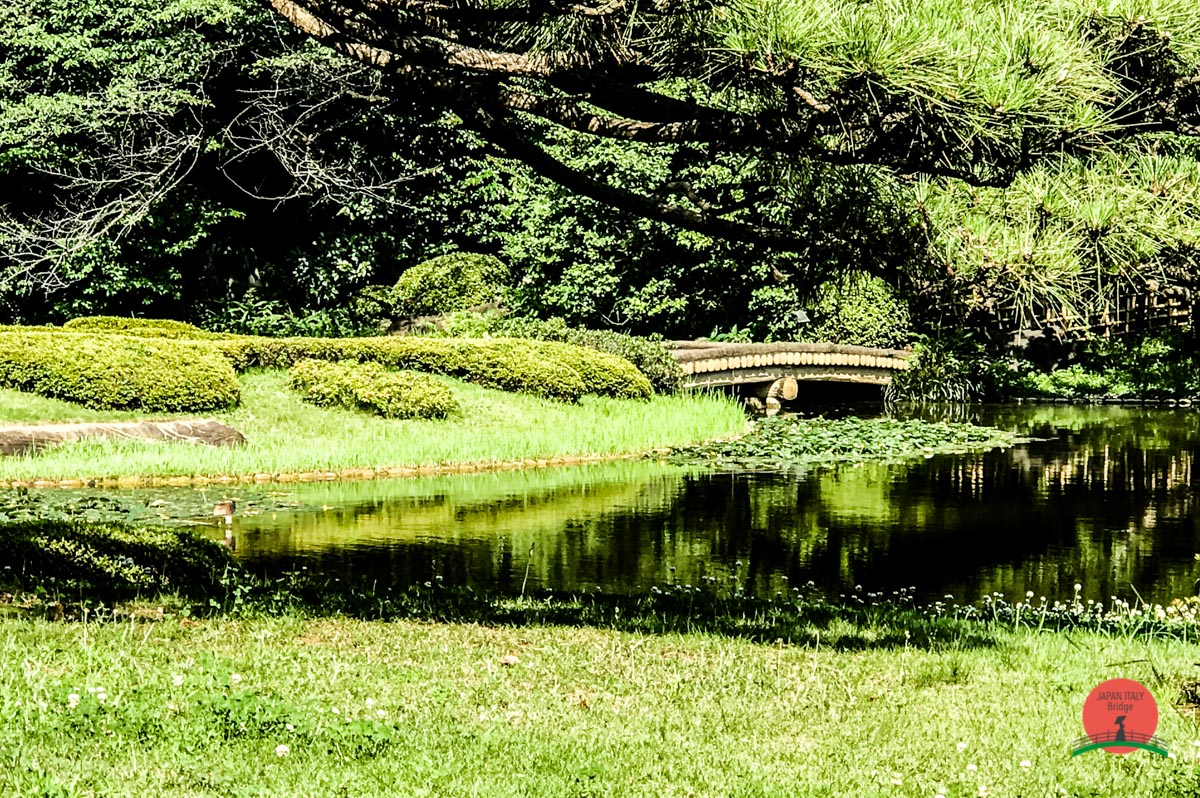

Fukiage Garden
This is probably the oldest garden of the complex. The Fukiage Garden has carried the name since the Edo period and this is where the Imperial Family lives today.
The Fukiage Ōmiya Palace (吹上大宮御所 Fukiage Ōmiya-gosho) in the northern section was originally the residence of Emperor Showa and Empress Kōjun and was called the Fukiage Palace. After the Emperor's death in 1989, the palace was renamed the Fukiage Ōmiya Palace and was the residence of the Empress Dowager until her death in 2000.
Here you can also find the Three Palace Sanctuaries (宮中三殿 Kyūchū-sanden), parts of the Imperial Regalia of Japan and the sanctuary plays a religious role in imperial enthronements and weddings.


photo credit: Wikipedia
Tōkagakudō (Music Hall)
The Tōkagakudō (桃華楽堂, Peach Blossom Music Hall) is located to the east of the former main donjon of Edo Castle in the Honmaru and it was built was built in commemoration of the 60th birthday of Empress Kōjun on 6 March 1963. The ferro-concrete building covers a total area of 1,254 m2 (13,500 sq ft) and each of its eight outer walls is decorated with differently designed mosaic tiles.
Ninomaru Garden
If you want to have a quick look of the whole Japan vegetation, this is where you should be since symbolic trees representing each prefecture are planted in the northwestern corner of Ninomaru enceinte. Such trees have been donated from each prefecture and there are total of 260, covering 30 varieties.

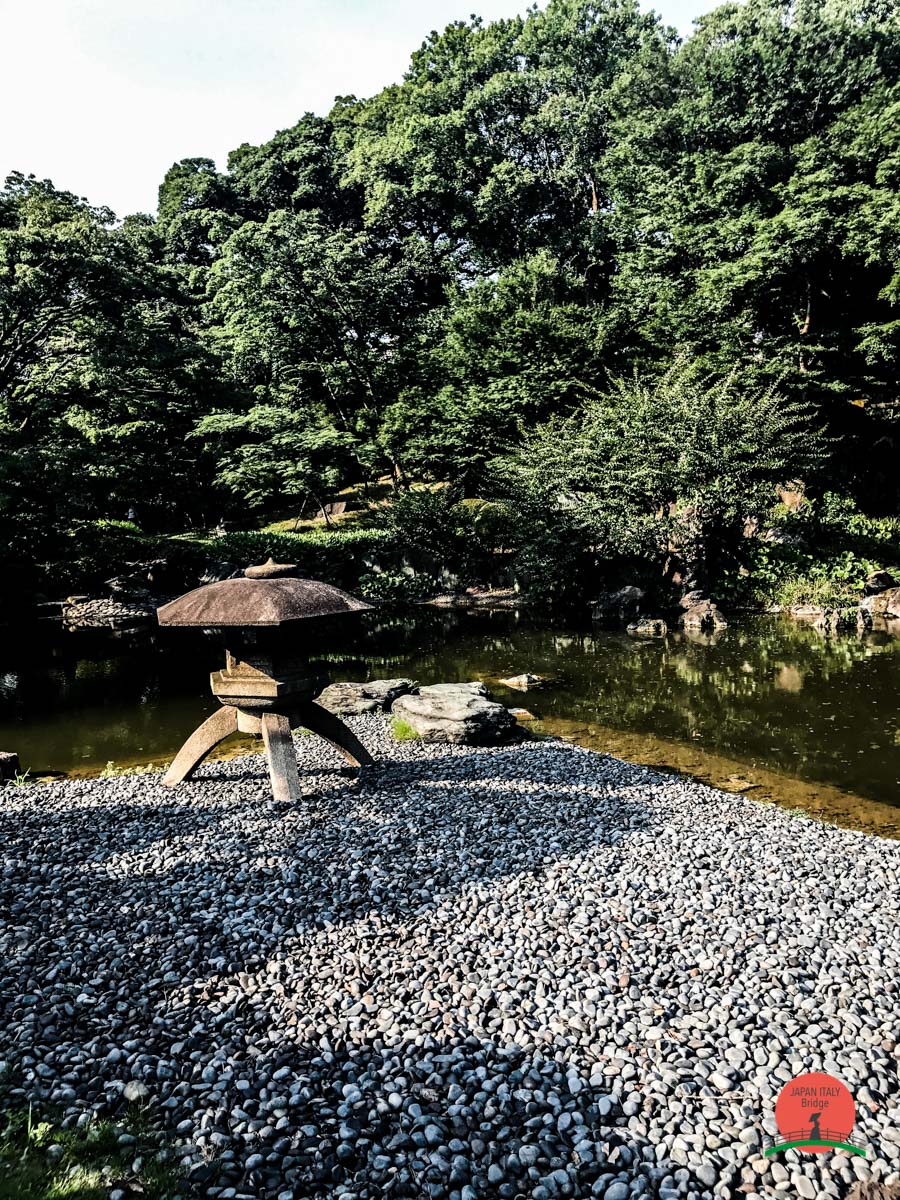
Kitanomaru
Located in the northern part of the enceinte of Edo Castle, this public park is famous for being the house of the Nippon Budokan Hall, one of the biggest sites for concerts, sports event and more.
Here you can also find a bronze monument dedicated to Prince Kitashirakawa Yoshihisa (北白川宮能久親王 Kitashirakawa-no-miya Yoshihisa-shinnō).
East Garden
And last but not least, the East Gardens the most famous of this whole complex. This is where most of the administrative buildings for the palace are located and encompasses the former Honmaru and Ninomaru areas of Edo Castle, a total of 210,000 m2 (2,300,000 sq ft). Located on the grounds of the East Garden is the Imperial Tokagakudo Music Hall, the Music Department of the Board of Ceremonies of the Imperial Household, the Archives and Mausolea Department Imperial Household Agency, structures for the guards such as the Saineikan dojo, and the Museum of the Imperial Collections.
Construction work began in 1961 with a new pond in the Ninomaru, as well as the repair and restoration of various keeps and structures from the Edo period. On 30 May 1963, the area was declared by the Japanese government a "Special Historic Relic" under the Cultural Properties Protection Law.


This is actually my personal favourite and whenever I come to Tokyo, I always try to spend one afternoon here. It’s one of the most visited landmarks of the city, that’s true, but in spite of all the tourists walking around, there is this magical atmosphere of tranquillity in the air and it’s the perfect spot to just sit, read a book, write on your notebook all the adventures you’ve had in this amazing city and just take in all the history this place has seen.
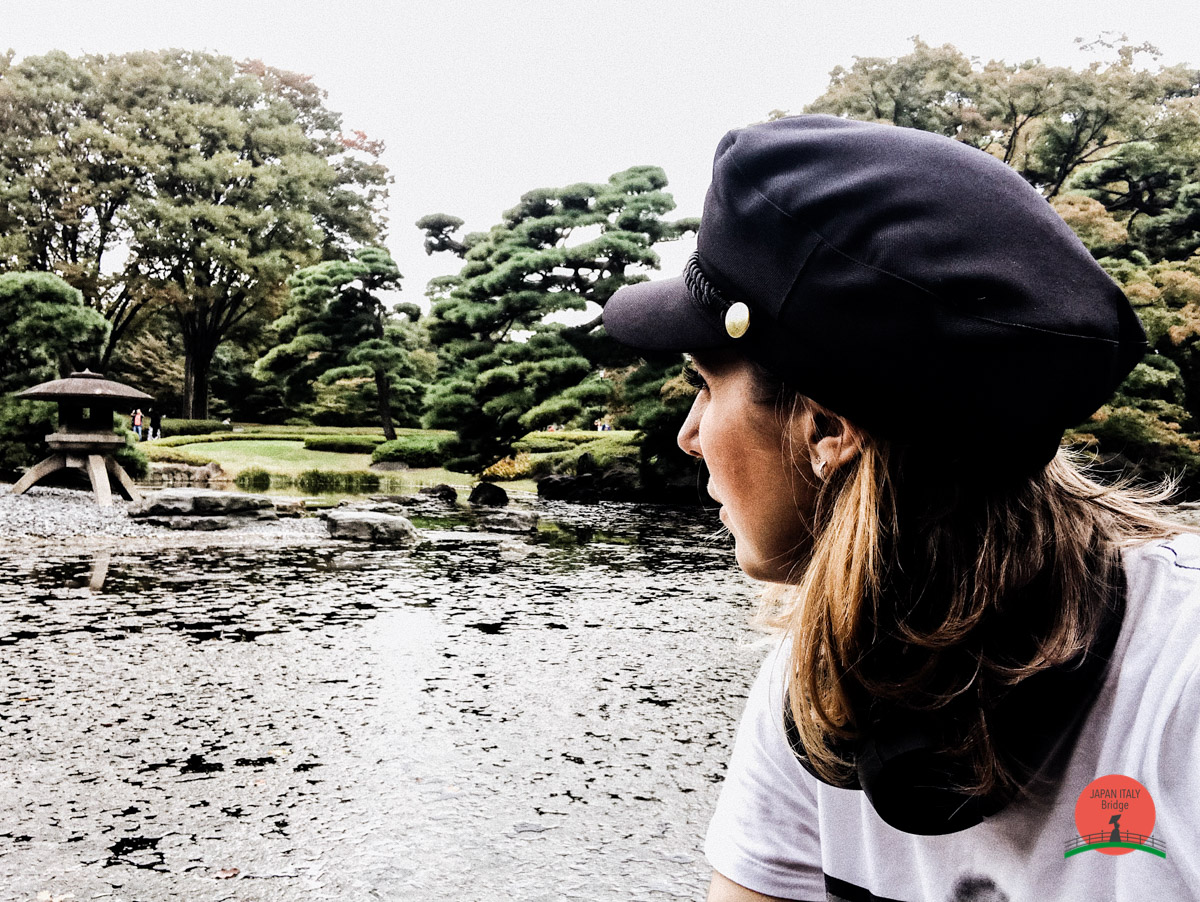
Access
The Otemon entrance to the East Gardens is a short walk from Otemachi Station on the Chiyoda, Tozai, Marunouchi, Hanzomon and Mita Subway Lines. It can also be reached in a 10-15 minute walk from Tokyo Station.
Opening Hours
9:00 to 16:30 (until 17:00 from mid April through August; until 16:00 from November through February). Admission ends 30 minutes before closing.
Closed
Mondays, Fridays, New Year (Dec 28 to Jan 3) and some special occasions. If Monday or Friday is a national holiday, the gardens are closed on the following day instead.
Admission
Free
Japan Travel: Planning a trip to Japan
A country of contrasts and contradictions, Japan is one of the most desirable travel destinations in the world. Even among Asian countries, Japan has its very own culture that is unique from all the other nations in the region. History and tradition thrives together with modernisation from the progress made in the last century. It is this impeccable co-existence that gives this nation it’s unique scenery that is unlike the typical Westernised civilisation. This is the only place where you can see ancient temples and shrines, Geishas, and old tea houses situated right next to the world-famous bullet train and service robots.


Japan is a relatively small country compared to other countries, so it’s very easy to travel from top to bottom. Every city has its own character and vibe which you will discover, regardless of whether you explore just the highlights or dive deep into the culture.
However, if you’re planning for your first trip to Japan may be a daunting task. So in this post, we will share with you some tips that may come in handy when you wish to begin your Japanese adventure.
When to visit Japan
If you love Japan, you may want to visit the country during one of the most significant seasons of the year for the locals. Hanami (cherry blossom viewing; second half of March through May) is widely known as one of the most beautiful seasons to visit Japan. And despite the elevated costs during this period of time, it is still very popular season for visiting.
If you decide to visit Japan and its capital during summer, brace yourself for the heat, the humidity, and get ready to sweat. Summers in Japan, especially in the central and southern regions country, are known to be very hot and humid. The weather is, however, pleasant on most days.
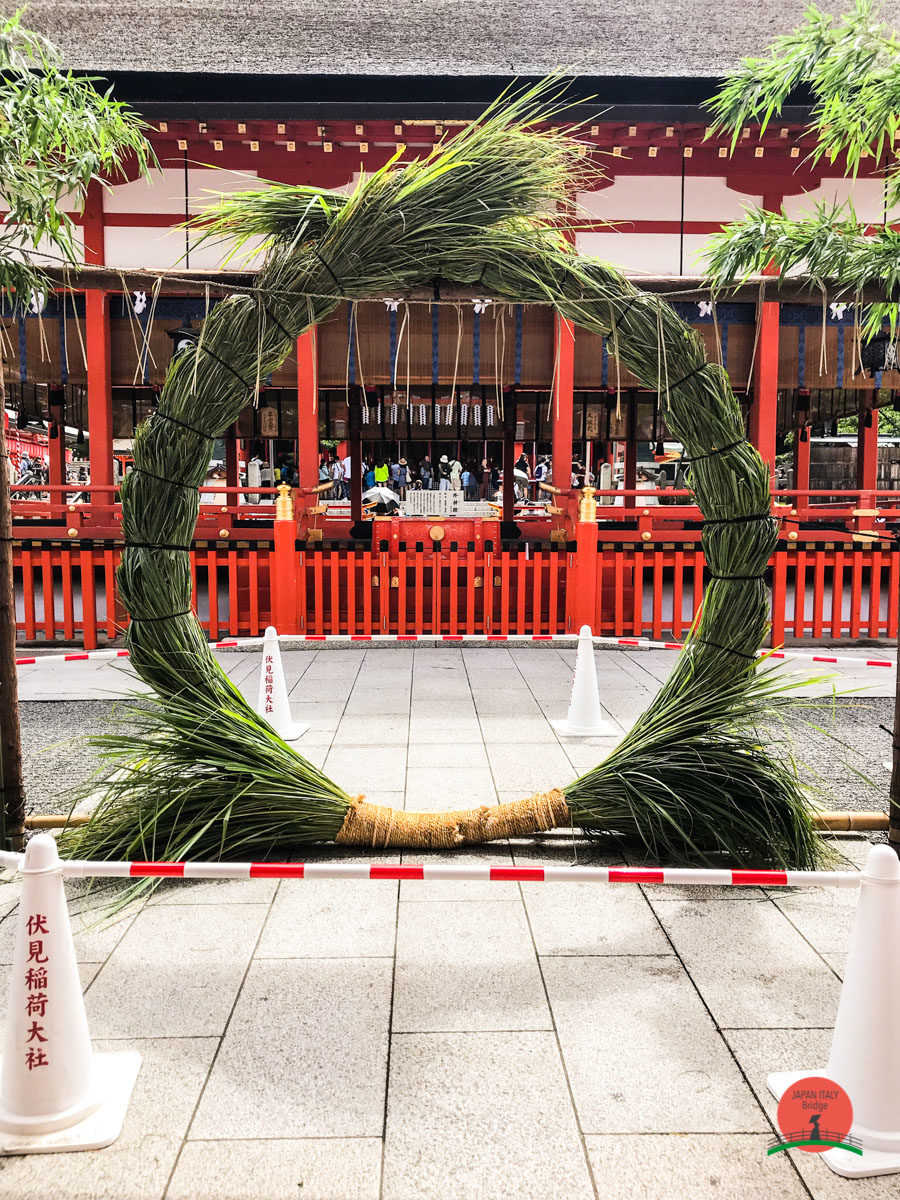

If cherry blossoms are not your cup of tea, the fall season in Japan is another wonderful period for beautiful scenery, with the autumn foliage turning summer greens into fiery reds. The weather will be mostly cool, and dryer than summer too.
Aside from these, you can always visit the holiday season between Christmas and New Year’s Day. Every year, cities light up with festive illuminations to create a magical and mystical atmosphere. It goes without saying that these are better experienced at night. The weather during these weeks are not typically too cold, but there may be snow depending on which region you visit, so do make sure to pack warm clothes.
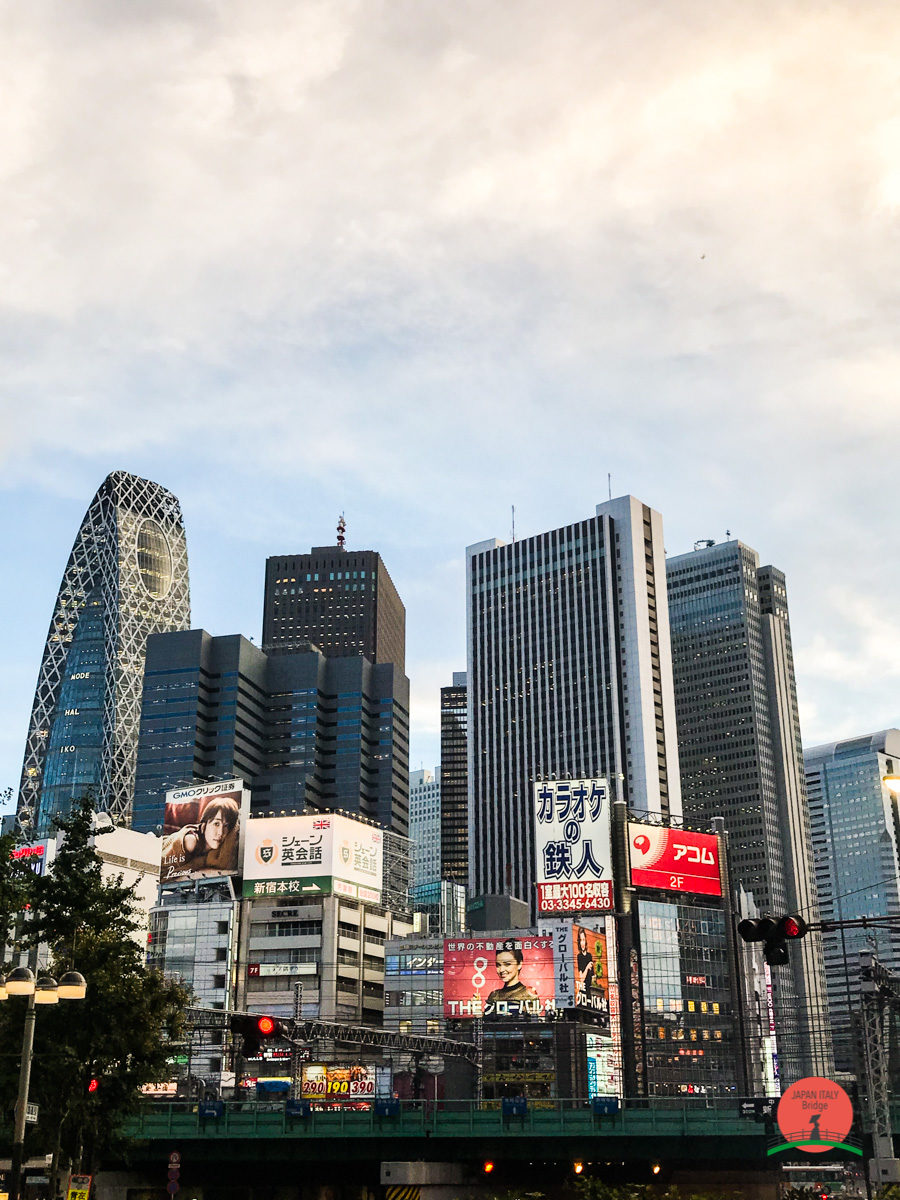
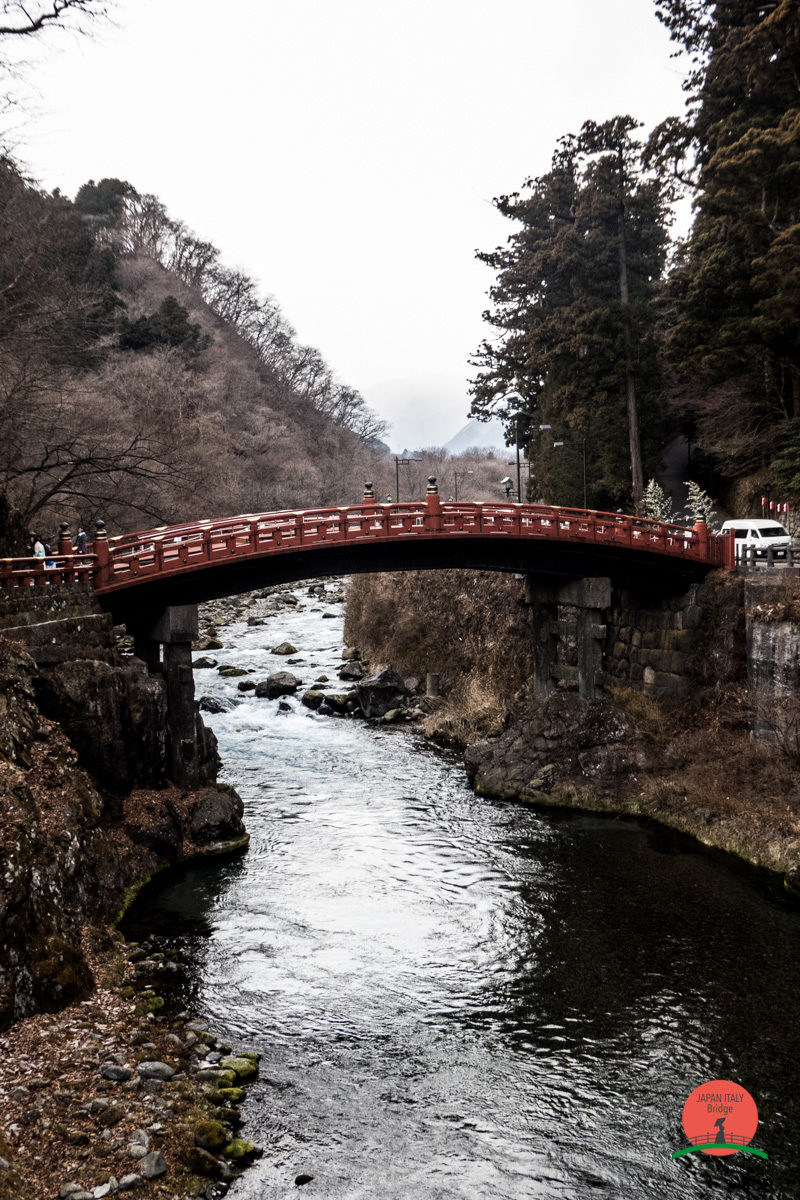
How long to stay in Japan
Even if Japan looks small on the world map, this country’s vibrant culture means that it is filled with unique sights and experiences for you during your visit. Touring the whole country in one go will be a rather expensive trip. So, if you are planning to stay for more than two weeks in this amazing place, do make sure to plan your spending and allocate the right amount of money for each day.
Which cities to visit
No matter how long you decide to stay in Japan, these places should be on your list of must-go’s. Usually the routes are the same for every trip. So here’s our suggestions for traveling if you wish to restrict yourself to the main cities of Japan
1. Tokyo
2. Nikko
3. Takayama
4. Hiroshima
5. Kyoto
6. Osaka
7. Nagoya
8. Yokohama
9. Niigata
10. Sendai
11. Sapporo
Basing yourself in any of these cities will give you access to make shorter day trips to neighbouring cities and towns. Do note that although the big cities are touted as the main highlights of Japan, the country’s less widely-known destinations are filled with hidden treasures that you can uncover.
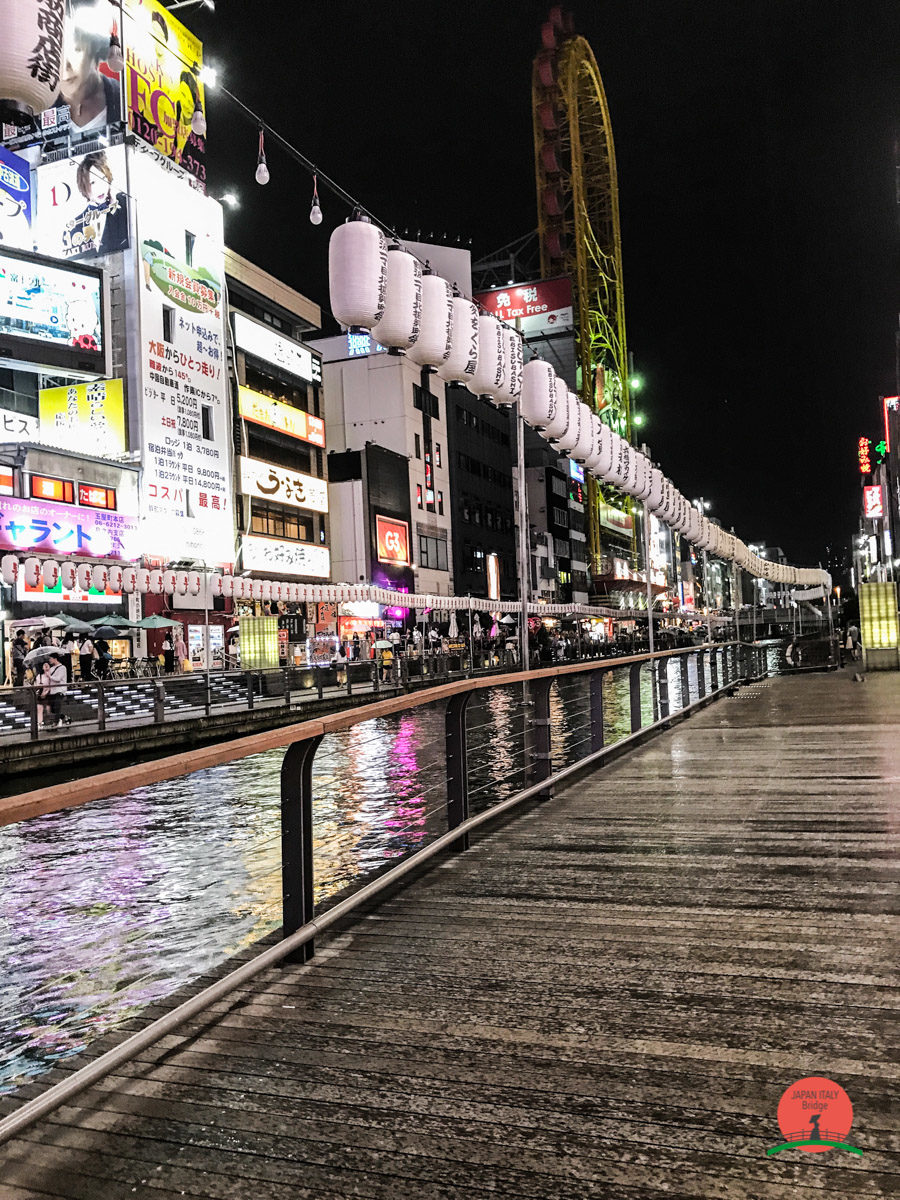

Travel Budget
Japan has the unfortunate reputation of being an expensive country. Although that may be true, it is, in fact, not that much different from any other country like Italy or England.
You can adapt your travel budget according to your preferences and what you have, and there are plenty of ways to save money.
You can find several combinations of deals that include both flights and accommodation online on websites.
Transportation
When you fly to Tokyo, the capital of Japan, you will land in either Narita or Haneda airport. Japan has a wonderful transportation network that is very extensive and reliable. There are a variety of different apps that can help you find the routes to use. For trains and public transportations, the go-to apps are HYPERDIA and JR-EAST Train Info.
At every station, there are ticket machines where you can purchase the tickets, but when in doubt, you can always ask staff members at the station information desks. There will usually be someone who speaks basic English.

The Cards & Passes
Purchasing a ticket at the vending machines sometimes can reveal to be rather troublesome, especially if you don’t read the language. To make things easier, there are different cards you can use. Information about the various cards and passes are as follows:
- Japan Rail pass: This is a pass for the train system that you can use throughout all the JR rail line, the national train transportation company. You can purchase the pass only from abroad so you have to purchase it while you are still in your country. The pass has a 7, 14, or 21 consecutive days of validity. You can purchase the first class (Green) or second class (Ordinary). The quality standard on Japanese trains is very high, so even if you purchase the second class pass you can still travel very comfortably. Furthermore, there’s a 50% off discount for kids between 6 and 11 years old.


- Suica Card: this is a prepaid card. It can be used instead of train tickets but also as a normal prepaid card in some stores. The Suica card is valid throughout all Japan, it will also give you a small discount on the Tokyo subway and it’s very convenient because it will allow you to avoid going through the ticketing process each time you want to ride the train. You can buy it and recharge it through ticketing machine in every station. You may, alternatively, approach a ticket agent for it.
The Suica Card is valid on trains belonging to the JR East lines and on the JR trains of the following regions: Sendai, Niigata, Sapporo, Osaka, Okayama, Hiroshima, Nagoya Shizuoka. It is also possible to use it on some trains, busses and subways in the Fukuoka region.
On the Suica, you can recharge up to 20000 ¥. The initial cost to buy the card can be 1000, 2000, 3000, 4000, 5000 and 10000 ¥ and this include the 500¥ deposit.
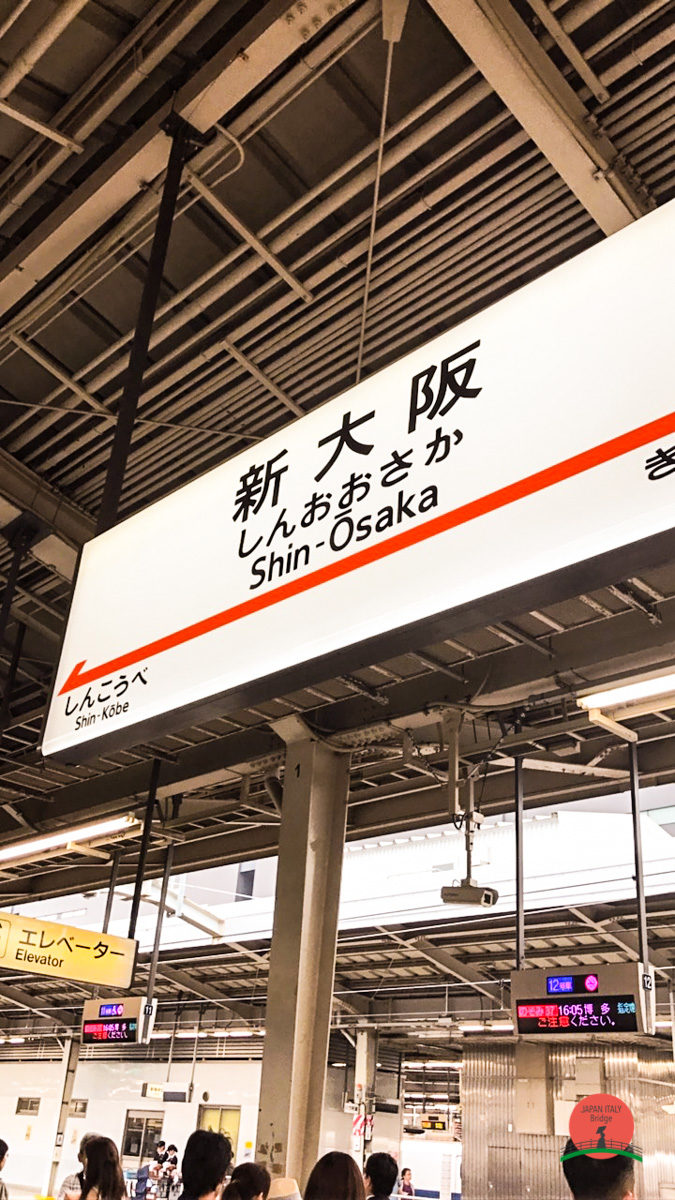

To use the Suica, rest the card on the blue sensor while facing the barriers at the subway/train. If the sensor will remain blue, the doors of the barriers will open and you can pass through. If the sensor becomes red, it means that you don’t have enough credit on the card and you will have to recharge it. It may be worth noting that these cards and the charged amounts in it remain valid for up to 10 years from your last ride.
- Pasmo: this is a card for Tokyo transportation and it works exactly like the Suica.
Accommodation in Japan
Hotels and accommodations are typically the most expensive part in of a trip to Japan. However, a very wide range of accommodation types is available in both Japanese and Western style interiors. Rates per night can range from less than 2,000 yen per person in a dormitory or capsule hotel to over 50,000 yen per person in a first class Hotel or Ryokan.
Ryokans (and their cheaper versions, the minshuku) are traditional Japanese guesthouses and are the best spots to learn about the cultural traditions relating to Japanese food and hospitality. This is something unique that can only be experienced in Japan. As such, if your budget allows it, do plan to stay in one of these places for a couple of nights. Japan also has capsule, or pod, hotels where you essentially sleep in a high-tech version of bunk beds.


Japanese Food
Japanese cuisine is one of the best in the world, offering a balanced diet in a wide variety of gastronomical delights and seasonal dishes. Restaurants and eateries are easily found, from the world-famous, Michelin-starred restaurants to the local hole-in-the-wall stands that are popular among the locals. Although sushi and sashimi are most famous Japanese dishes known around the world, Japan actually has such a large variety of foods that there really is something to eat for everyone. Many of the best establishments are, however, typically specialised in one type of food.
Sushi, Sashimi, Kaisen Don, Tempura, Katsu Curry, Udon, Soba, Ramen, Yakitori, Takoyaki. These just are some of the dishes you should definitely try while exploring the land of the Rising Sun.
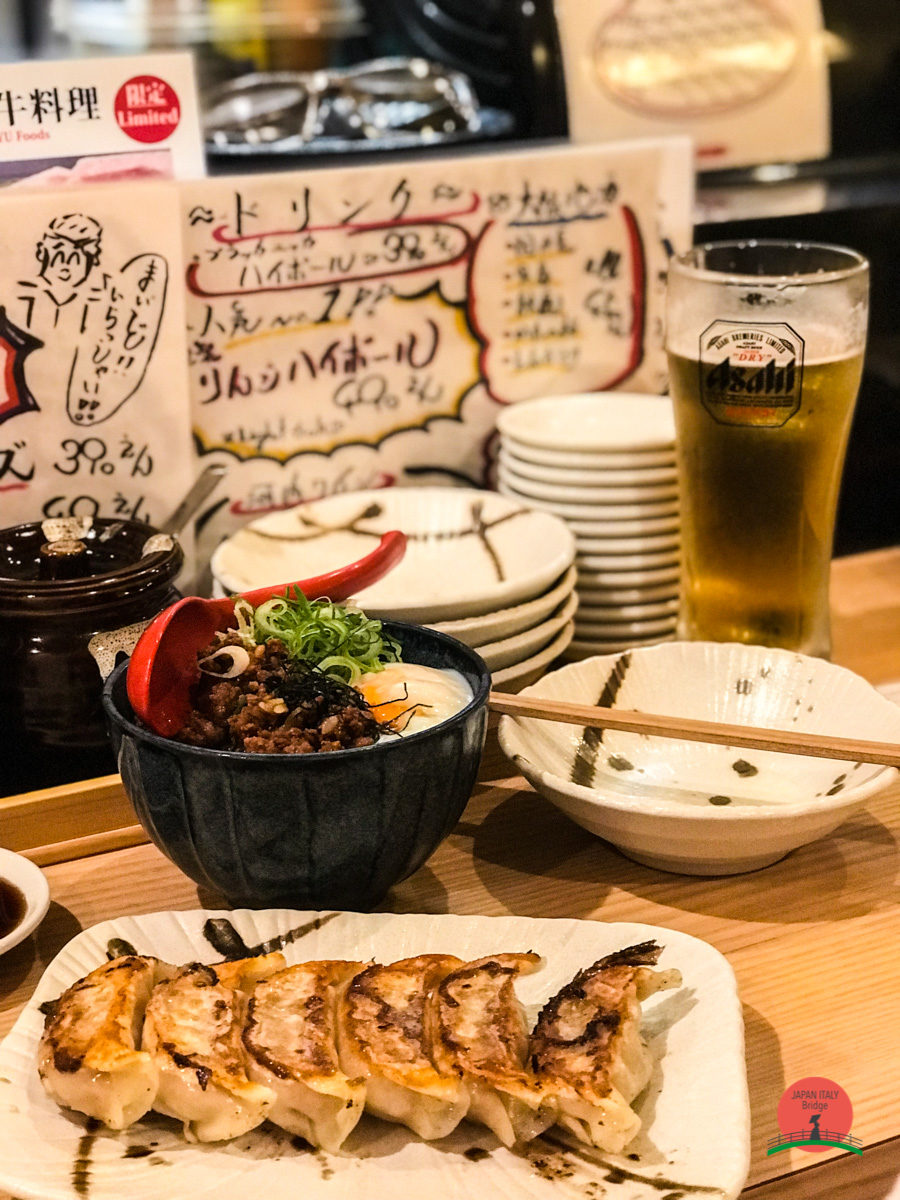

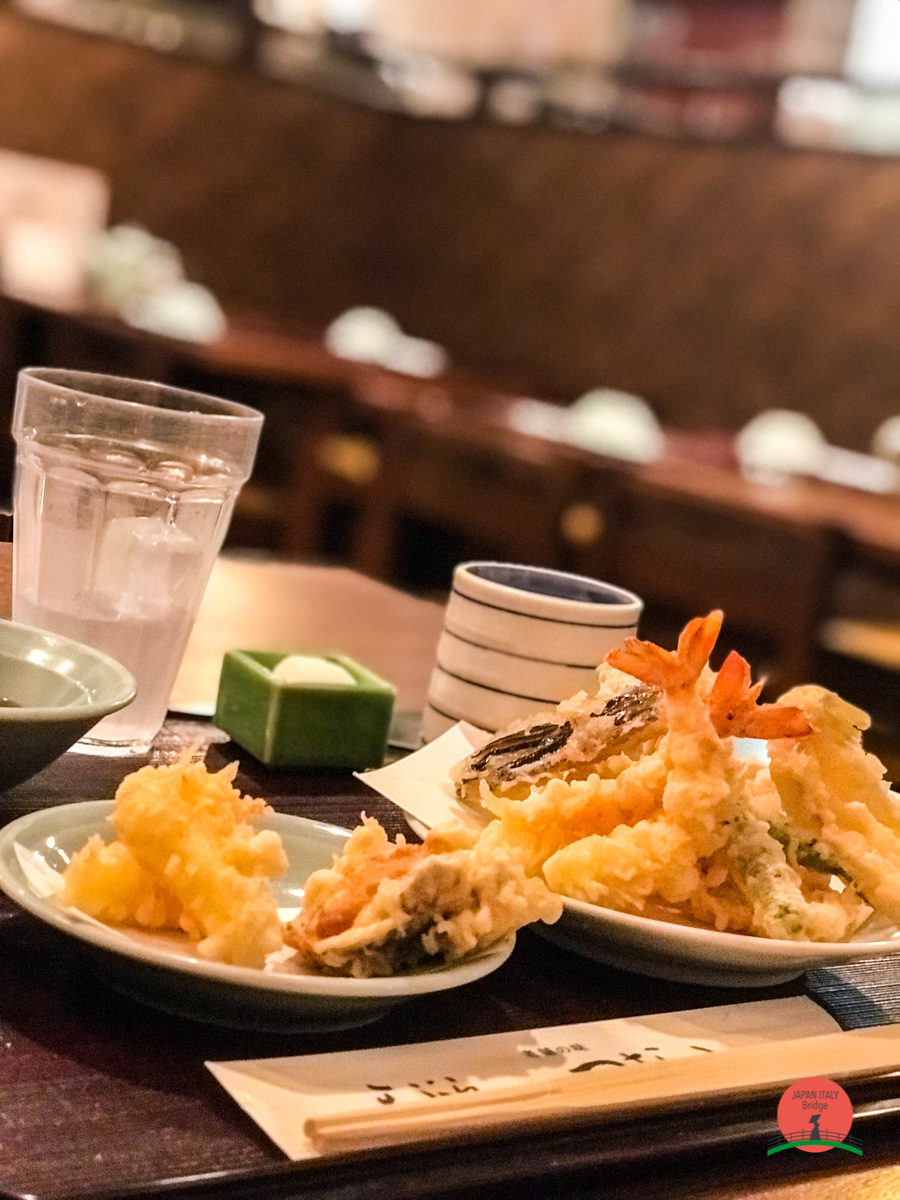
Luggage in Japan
No matter how long you are staying in the country, you may want to try to pack light. Most hotels rooms are very small and sometimes, there may not be enough space to have large suitcases lying around. Packing light is especially important if you plan to travel mostly by public transportation. Do remember that most trains do not have space for bulky luggage and despite the highly advanced train system, not every station is equipped with escalators or elevators. Furthermore, most hotels don’t allow checking in before 2 or 3 p.m., so do make concessions for holding onto your luggage until then.

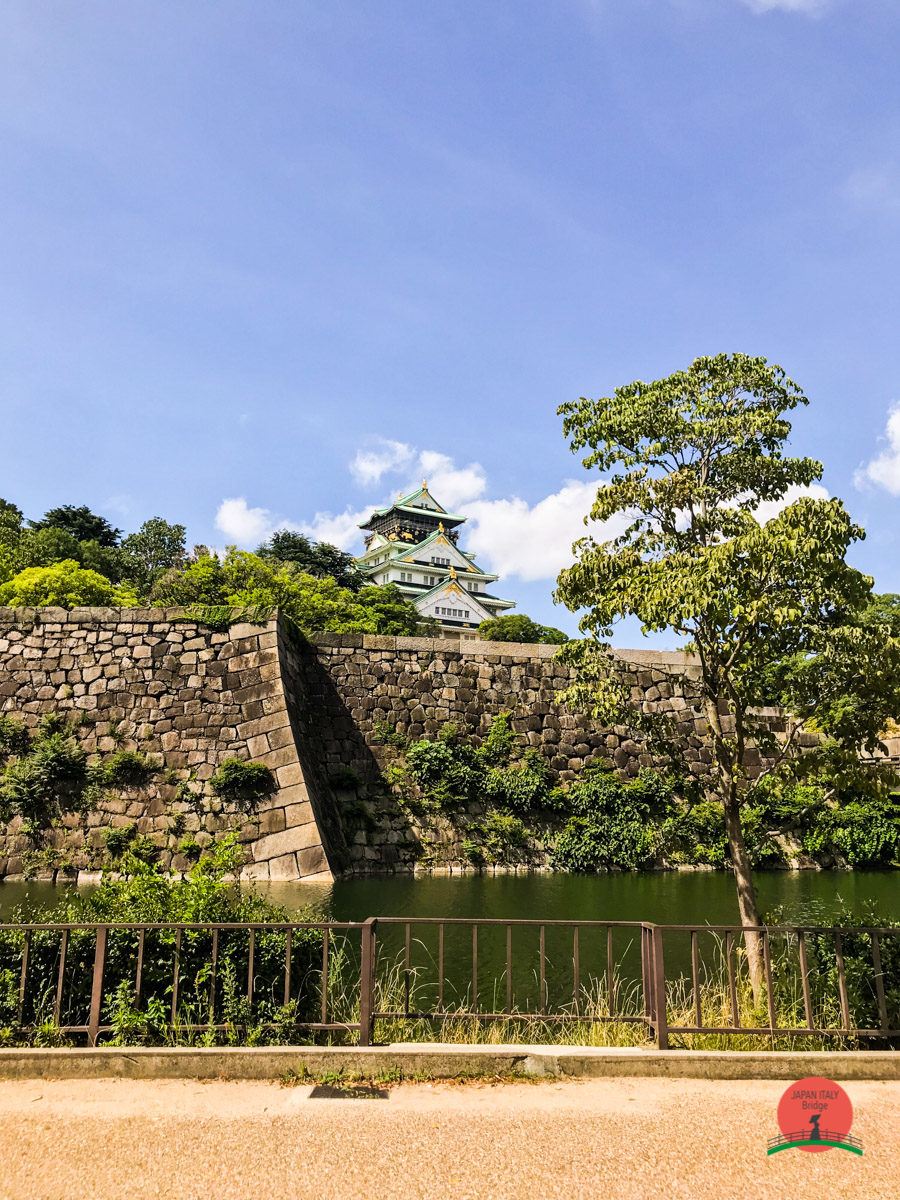
Other things to note
Currency: Japanese Yen (JPY)
Electricity: 100V/50-60Hz (North American plug; usually two-pronged. Often has both flat pins the same size. You may need an adapter.)
Main Airports: Tokyo’s Narita Airport (NRT). Tokyo’s Haneda Airport (HND). Osaka’s Kansai Airport (KIX).
Water: Safe. Bring a water bottle and fill from the tap as you travel.
Internet connectivity: Japan has excellent internet, among one of the fastest connections in the world.
Local SIM: I highly recommend you secure a SIM card or pocket wifi once you land. Although it’s not cheap, it is handy and it will allow you to save on international data plans with today's communication apps. This will also allows you to use tools like Google Maps in case you get lost.
Visas: Citizens of North America, UK, and Europe do not need a visa to enter for 90 days. Longer extensions are available for some of these countries, and most outside of these regions will need to apply ahead of time. Full visa requirements here.
Noteable festivals: Hanami, or rather Cherry Blossom viewing season is one of the most popular times to visit (end of March through May). Sapporo Snow Festival (February). Fuji Rock Festival (July). Golden Week (April 29 – May 5 — it’s nearly impossible to find accommodation during this week.)
Safety: Japan is incredibly safe. It’s in the culture of every citizen to follow a rigid set of societal rules. Young children travel alone, riding the subway and walking to school on their own with no problems. Scams are rare. There are some reports of sleazy behavior by men on the trains, but such cases rarely occur.

Japan Travel: Hanami
Hanami
About Hanami, or the Flower viewing.
In Japan, spring is synonymous with Hanami. Written with the kanji: Hana 花 "flower" and mi 見 "viewing", the word hanami means enjoying the beauty of blooming flowers. In particular, it refers to the Sakura: cherry blossom.
To understand the profound meaning of this magical tradition, Yosa Buson's haiku is perfect:
“Cherry petals
in the rice-seedling water,
moon and stars.”
In these words we read the aesthetic symbolism behind the relationship between nature and human beings in which everything becomes harmonious. Spring is, in fact, a "rebirth", therefore a renovation of the soul and of the spirit. The falling flowers indicate the transience of things. As flowers reach the peak when they bloom and then fall to be carried away by water, beauty is therefore wonderful and ephemeral at the same time. In Japanese, we can summarize this concept in the small sentence 物の哀れ, "mono no aware". This aesthetic concept expresses a strong emotional participation toward the beauty of nature and human life, with a consequent nostalgic feeling linked to its incessant change.
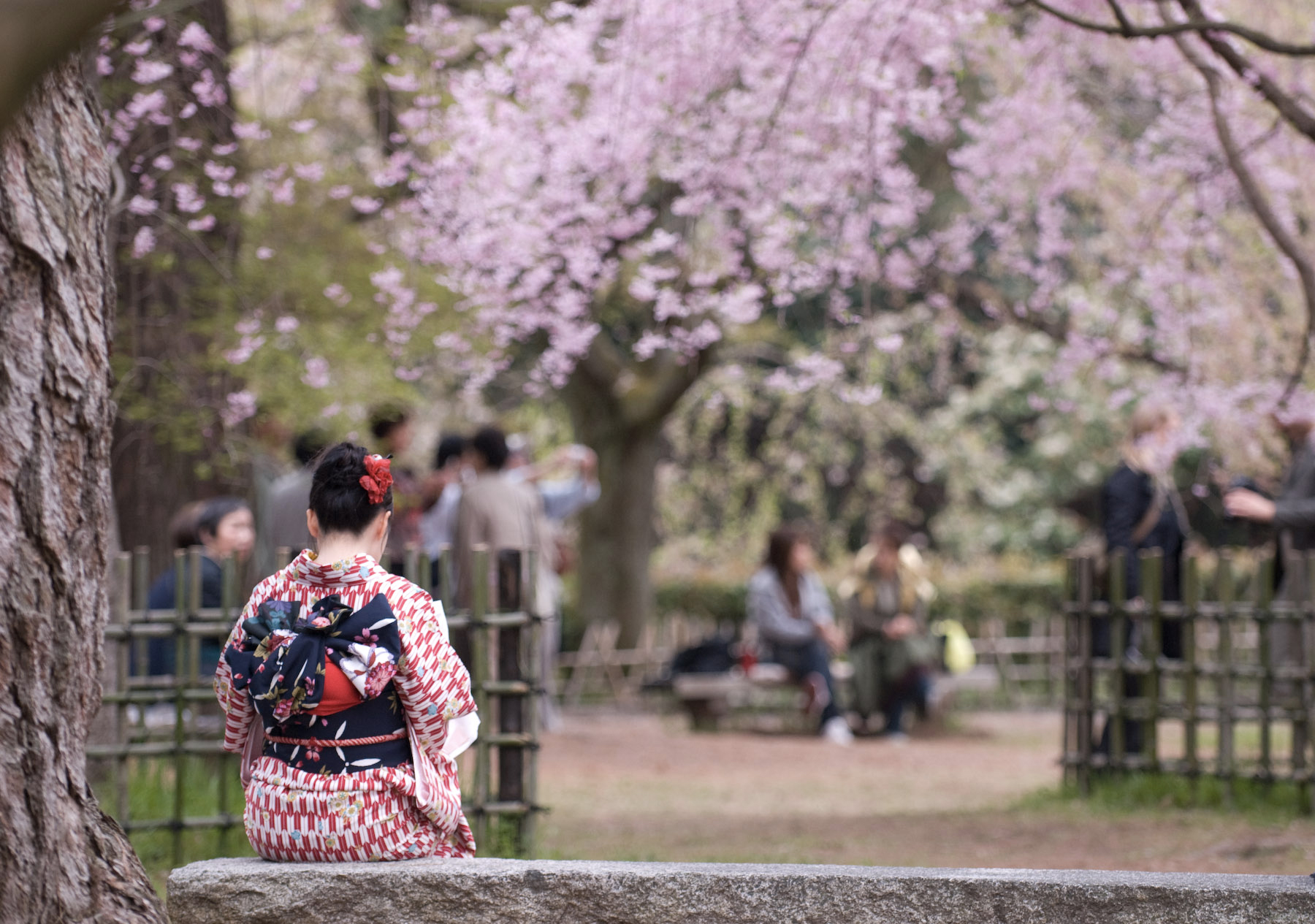
Photo Credits: regex.info
The Roots
Yoshino hills is where cherry trees originated in Japan. The legend says that in the VII century the priest En-no-Ozuno planted some sakura trees casting a curse on them. The curse would hit anyone who dared to cut the trees down. However, there are those who say that the hanami came from China, at the time of the Tang dynasty, which influenced Japan in the Nara period. Originally, there where the “ume” (prunus trees) to offer viewers the spectacle of their flowering. During the Heian period (794-1185) however, the Japanese imperial court moved to Kyoto where the unparalleled beauty of the cherry trees outshone that of the prunus.
Murasaki Shikibu, the court-lady that wrote the "Genji Monogatari”, the first novel ever written, used the word “hanami” related to the cherry blossom viewing for the first time. In the beginning, it was a rite restricted to an elite of nobles, dignitaries, samurai and poets, that drank sake and recited haiku on the beauty of the cherry blossom. In the following Edo period, the hanami spread to lower classes as well, eventually becoming a national holiday. This was also thanks to the shogun Tokugawa Yoshimune that planted areas of cherry blossom trees all over Japan.

Photo Credits: kabekin.com
Between Beauty and Transience, Hanami today
The hanami takes place in a period of time that extends from March to April when sakura reaches their blooming season. Traditionally, people gather together laying out their blue tarps under the trees and, armed with their bento, enjoy the spectacle of nature eating traditional dishes. Among them we can find the hanami-dango, rice dumpling of three colors: pink, white and green, accompanied by green tea and lots of sake. Another typical dish is the sakura mochi, a sweet made of red bean paste and rice, all wrapped in a pickled cherry blossom leaf. And the enjoyment goes on until the evening arrives, culminating in the Yozakura 夜桜 when the night is illuminated by chochin, traditional colored lantern made of paper.

Photo Credits: thespruce.com
Chasing after the best view
Japan is completely invaded by the simultaneous blooming of the trees awaken from the winter torpor, something that strikes the heart as well as the eye. But there are places where the charm of nature is more overwhelming than anywhere else. Among the must-see spots there is the Maruyama park in Kyoto, that is famous for the Shidarezakura, the unique weeping sakura. In Tokyo we can find the Ueno Park with its ancient temples and the Shinobazu pond. The Himeji castle, Hyōgo prefecture, is surrounded by a labyrinth-like wood of cherry trees, while the Hirosaki Castle, Aomori prefecture, is famous for its 2,600 cherry trees. Also, Mt. Yoshino, Nara prefecture, is where 100.000 cherry trees stand out on top of the mountain.
Japan Travel: Fushimi Inari
Fushimi Inari

Photo Credits: japanitalybridge.com
Thousands of vermilion gates
A trail made of many vermillion torii, one after the other: this is the most recognizable symbol of the Shinto shrine Fushimi Inari Taisha (伏見稲荷大社). The complex is located in Fushimi ward, south of Kyoto, and it is the most important of several thousands of shrines dedicated to the kami Inari. Inari is the Shinto deity protector of the prosperity and wealth of crops, especially rice.
Reaching this holy place is very simple as it is located opposite the JR Inari station. Alternatively, you can walk a short distance from Fushimi Inari Station served by Keihan Main Line
This is a temple of ancient origins and its foundation dates back to before 794, when Kyoto became capital. Initially built on the Inariyama hill, southwest of Kyoto, it was re-located in 816 on the request of the monk Kourai. The current main structure of the temple was built in 1499.

Photo Credits: japanitalybridge.com
At the entrance there is the Romon Gate which was donated in 1589 by the famous leader Toyotomi Hideyoshi (he was a famous samurai and daimyō of the Sengoku period, founder of the Toyotomi Clan. Succeeding his master Oda Nobunaga in the work of reunification of Japan, he is considered as the second of the three "great unifiers".)
Beyond the Romon Gate stands the main hall of the shrine (honden) where visitors should make a small offer as a sign of respect for the deities enshrined here.
At the back of the main land of the shrine there is the entrance to the hiking trail made of torii ( 鳥居 traditional Japanese gateway to a jinja, shinto shrine). The trail begins with two dense rows of parallel gates called Senbon Torii ("thousands of torii gates”). The torii straddle a network of trails leading into the flourishing forest of the sacred Mount Inari (Inari-yama), which stands at 233 meters above sea level. Each gate was donated by individual worshippers or companies and has an inscription indicating the name of the donor and the date of the donation itself.

Photo Credits: masterfile.com
The Fox
Along the trails there are the statues of sitting foxes (Kitsune 狐), especially placed in north-east locations, that have the role of guardians whose duty is to prevent the demoniac energy from entering the earthly world. Foxes are also considered Inari's messengers. According to tradition, Inari used to live in the mountains during the winter, coming down in spring during the growing season. After the harvest, Inari would once again return to his winter residence. Every season foxes approached humans’ houses in the same way and, over time, they were recognized as natural messengers of the god.

Photo Credits: japanitalybridge.com
They are a recurring subject and an element of particular importance for the Japanese culture. In fact, they represent sacred and mysterious creatures endowed with a great intelligence and strange supernatural powers that they develop with age. Their main skill is to change shape taking human form (as they often appear in the form of a beautiful woman). Another power they are said to have is that of the Kitsunetsuki (狐憑き o 狐付き) or else, the ability to possess human beings. It was believed that a fox was able to enter the body of its victims, usually young women, through a nail or their chest, thus feeding on their vital energy living inside their bodies.
Inari’s kitsune are white, a color considered to be auspicious. They possess the power to ward off evil, and sometimes act as guardian spirits. In addition to protecting the shrines of Inari, they protect the locals by acting as a scarecrow against the evil nogitsune, fox spirits who are not in the service of Inari. Black foxes and nine-tailed foxes are also believed to bring good luck.
Some of the foxes along the trails hold a key in their jaws that represents the key to the rice granary.
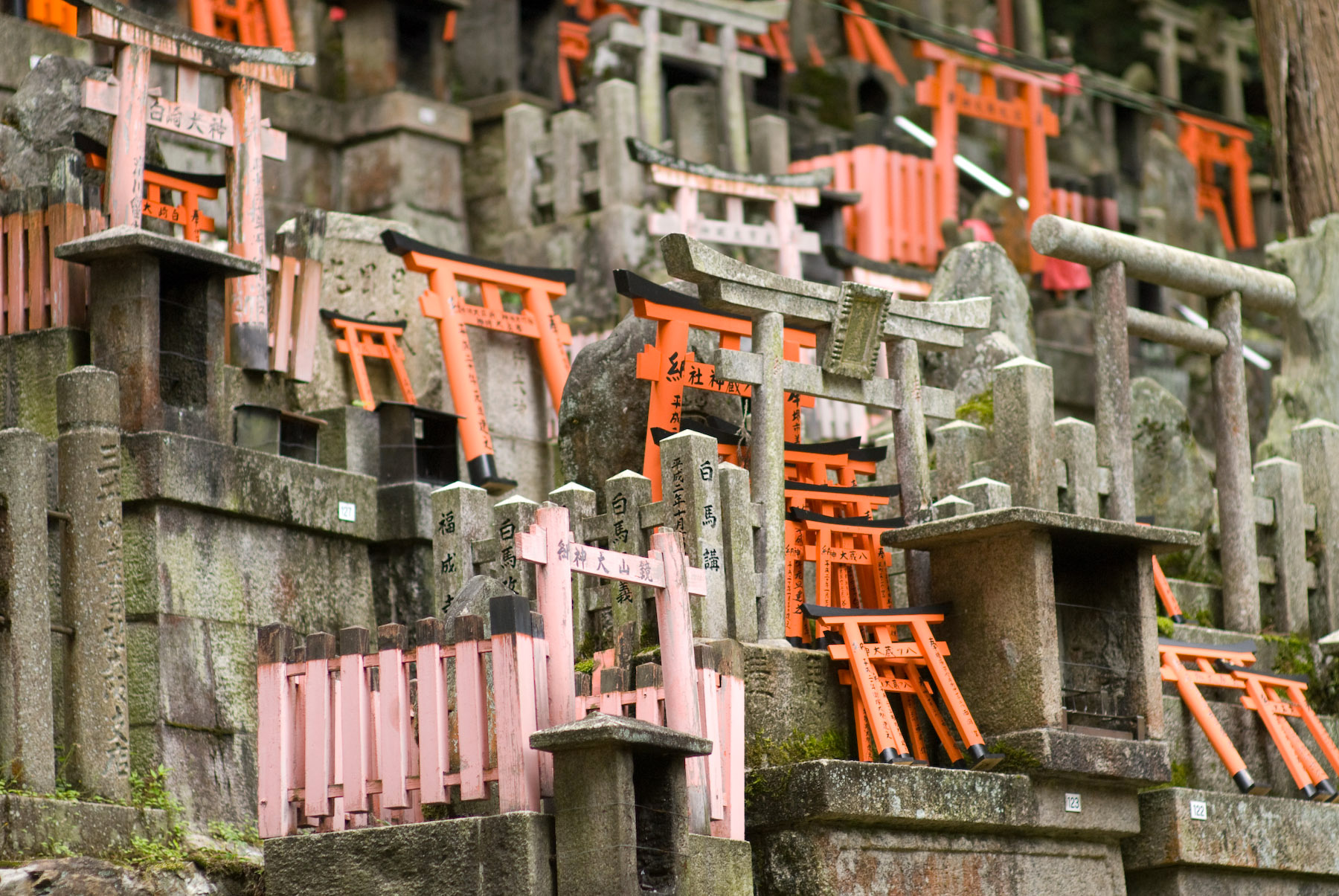
Photo Credits: regex.info
Up to the Inari-yama
Reaching the top of the mountain takes about 2 or 3 hours, and along the way there are many smaller shrines with piles of miniature torii donated by visitors on lower budgets. There are also some restaurants that offer local themed dishes such as Inari Sushi and Kitsune Udon ("Fox Udon"), both with pieces of aburaage (fried tofu), which is said to be the favorite food of foxes.
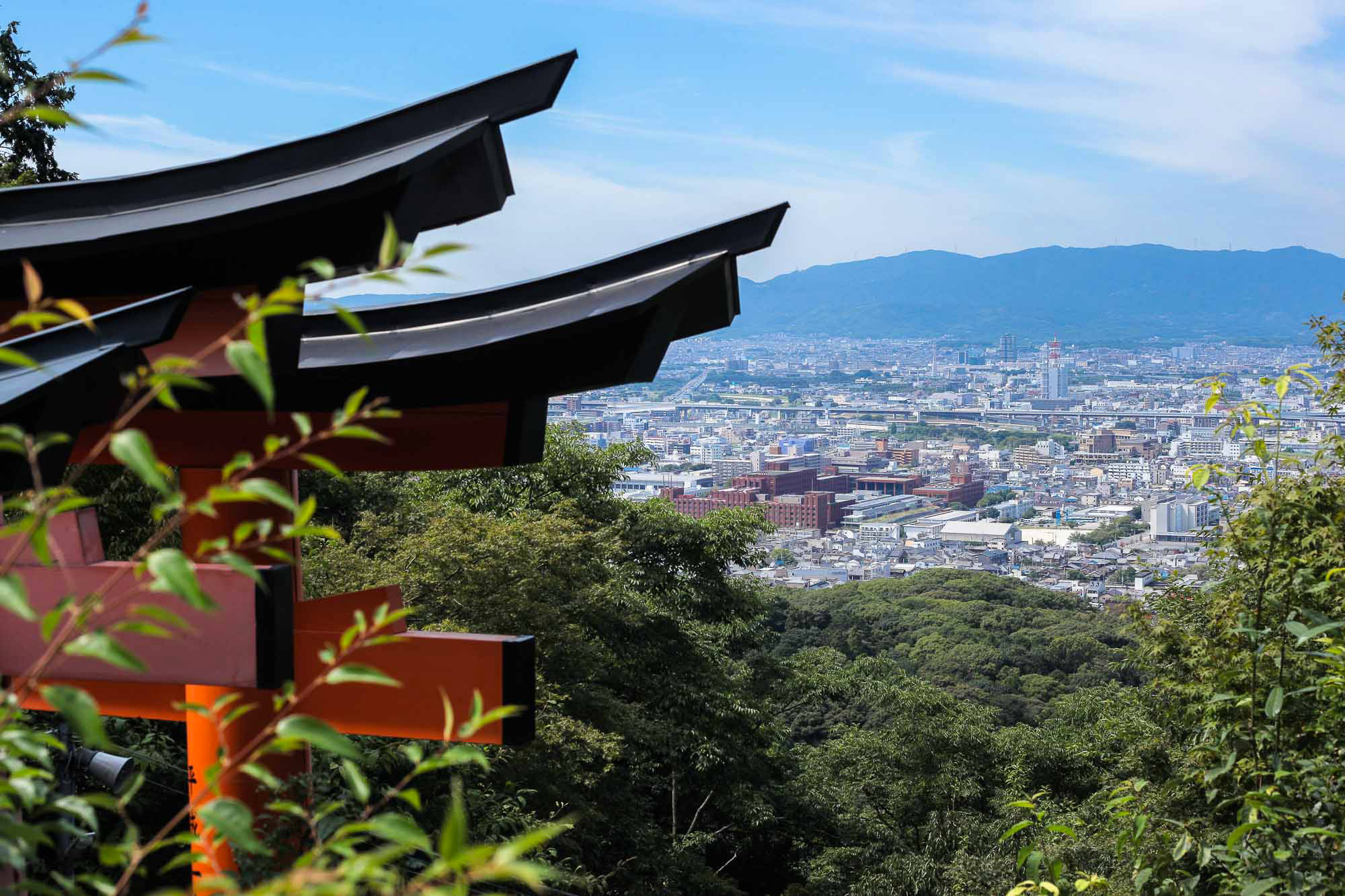
Photo Credits: crafttabby.com
After the first half hour of walking, the torii gates begin to gradually decrease until they reach the Yotsutsuji crossing, about halfway up the mountain. From here you can enjoy a splendid view of Kyoto.
At this point the trails divides into a circular path to the top.
Japan Travel: Aokigahara
Aokigahara
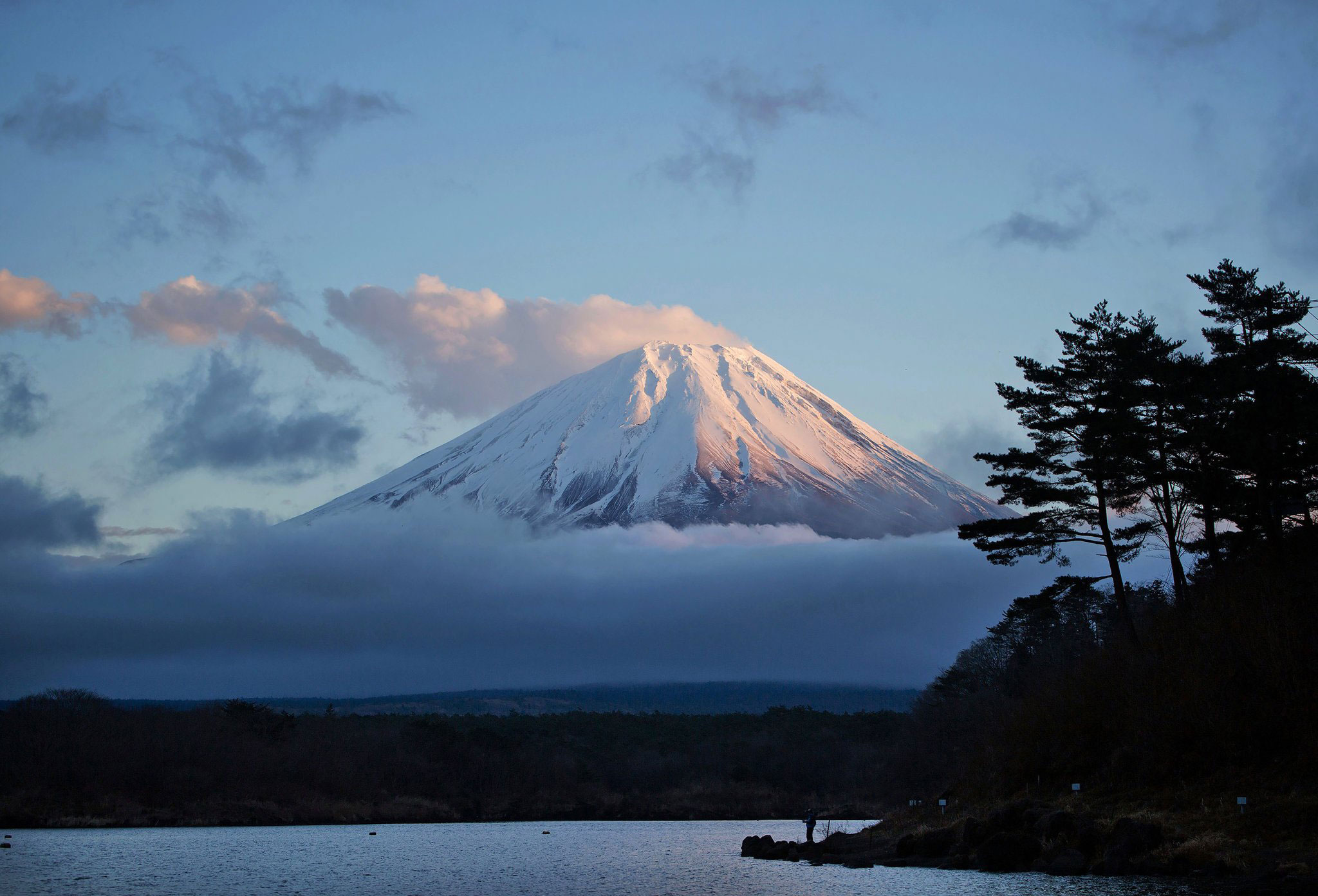
Photo credits: Ko Sasaki for The New York Times
Jukai, the sea of trees in which the soul drowns
At the foot of Mount Fuji, born from the volcanic eruption of Mount Nagao in 864 C.E., lies Aokigahara (青木ヶ原) best know with the name of Jukai (樹海, sea of trees). It is a thick forest that extends for 35 km² and that is made of caves and a maze-like vegetation with its cypresses, oaks and shrubs, including the Japanese snow flower. Its particular conformation prevents wind and solar rays from entering, giving it a spectral and silent appearance. In winter the thick fog that surrounds it forbids access to visitors who are even unable to find the entrance.
That of Aokigahara is a sad story because leaving the official paths means getting lost in its immense labyrinthine structure. Those who usually abandon the established path have only one intention: suicide. Due to this, it is not difficult to come across sign boards in both Japanese and English that try to dissuade people with macabre intentions.
“Your life is a precious gift from your parents”
“Please consult police or a doctor before you decide to die“
“Do not keep it to yourself, talk about your troubles”

Photo credits: Google images
The suicide forest
Statistics about Jukai, that go from 1950 up to today, will give you chills: from 30 to 105 suicides a year. In 1970 the Japanese government decided to set up a special annual patrol made of police officers, volunteers and journalists. This patrol is committed to searching and removing corpses, but this does not exclude the terrible possibility of running into skeletons and rotten bodies when walking through the forest. It is also possible to find Ema: wooden plaques on which suicides wrote their curses against those who forced them into taking their own lives.
Stepping away from the official path also means meeting colorful thread stretched between the trees, and this is because not all the people who enter the forest have decided to die. Some just want to reflect and these threads are necessary to find the way in case someone decides to live. However, following them almost always leads to something: some objects, an abandoned tent and, in the worst case, the lifeless body of someone who made the wrong choice.
There is another peculiarity that makes Aokigahara disturbing and mysterious: smartphones and all electronic devices stop working in the brush and the compasses go haywire. Finding the north is impossible. All this is caused by the high rate of magnetite, the mineral with the strongest magnetic properties.

Photo credits: Google images
The spirits of Jukai
In ancient times it was said that Kodama (木 魂) resided there, spirits of the trees that imitate the voices of the dead. Since they possess supernatural powers, cutting down a tree that is believed to house a kodama is considered a source of misfortune. The Japanese therefore use to mark the trunks of those trees with a sacred rope called Shimenawa. On the contrary, seeing a Kodama is considered a good omen because it means that the place is alive and full of positive energy.
But Kodama are not the only beings who are said to inhabit this place. The forest seems to be infested with real ghosts, the Yūrei. The term is made up of yū (幽 "flebile", "evanescent", but also "obscure") and rei (霊 "soul" or "spirit"). A Yūrei embodies the soul of those who died of violent death, because they committed suicide or because they were murdered. Unable to leave the world of the living, to reach the afterlife in peace they need to bring other lives with them.

Photo credits: Google images
Novels and Films in the mass culture
In 1960 Nami no tō (波 の 塔) "Tower of Waves" by Seichō Matsumoto was published, a book that speaks of two lovers who take their lives in the forest. Matsumoto describes Jukai as "the most beautiful abandoned and wild forest that exists. A perfect place to die in secret".
In recent years, Hollywood has created a series of films. In 2013, "Grave Halloween" came out, in which a young woman goes to Aokigahara with her friends to find her mother's body, a biologist who had disappeared in the forest. "The sea of trees" directed by Gus Van Sant comes to light in 2015, and the plot sees an American man who goes to Aokigahara to take his own life and there meets a Japanese man with the same intentions. In 2016, the horror-thriller "Jukai - The Forest of Suicides" invades cinemas, in which a girl travels to Aokigahara to find her lost twin sister.













